



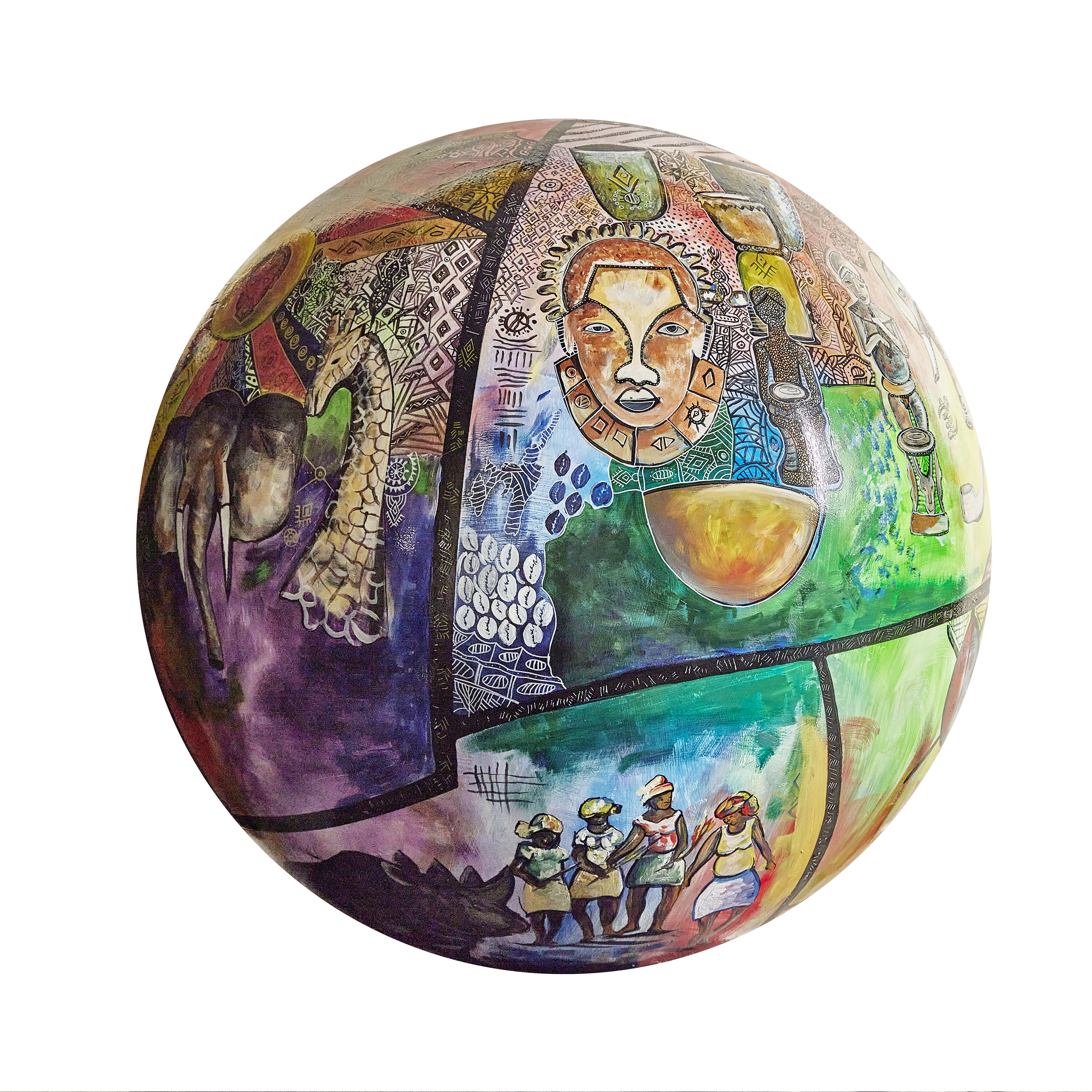
Mother AfricaI have painted my opinion of the greatness and glory of Mama Africa. I have endeavoured to include all regions of Africa, their cultures and their traditions, their customs and their natural resources. I carefully chose my colours to reflect t... |
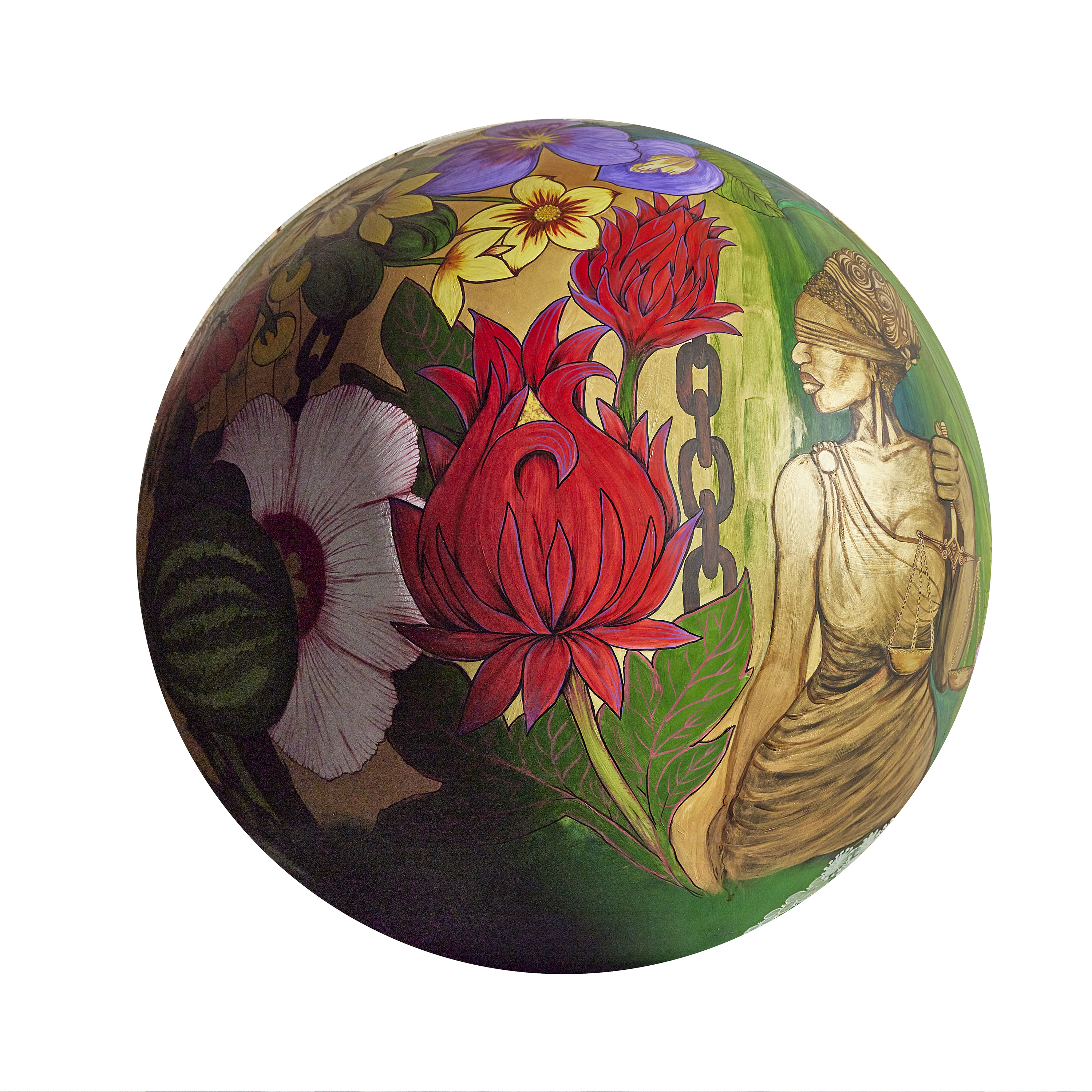
Sacred Healing WIsdomMuch ancient knowledge about the healthgiving and healing power of plants comes from Africa. This knowledge was passed on from generation to generation, from continent to continent, to enable people to heal, survive and even connect with the sacred. The history of these plants that are now... |
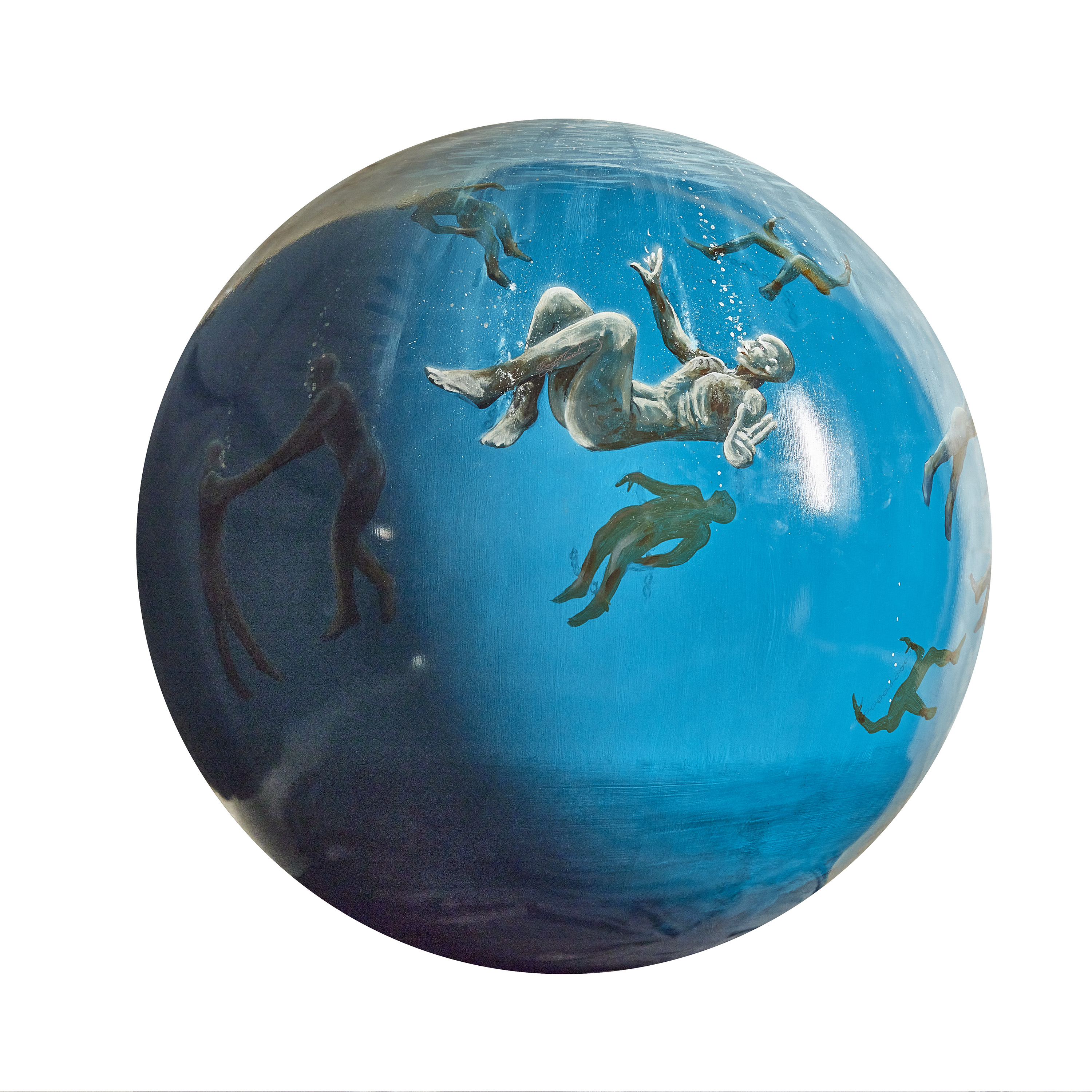
How Deep Is Your LoveI have always been very moved by the painting The Slave Ship by J.M.W. Turner. In his painting you see a ship in the background and hands rising out of the tumultuous waves. Turner exhi... |
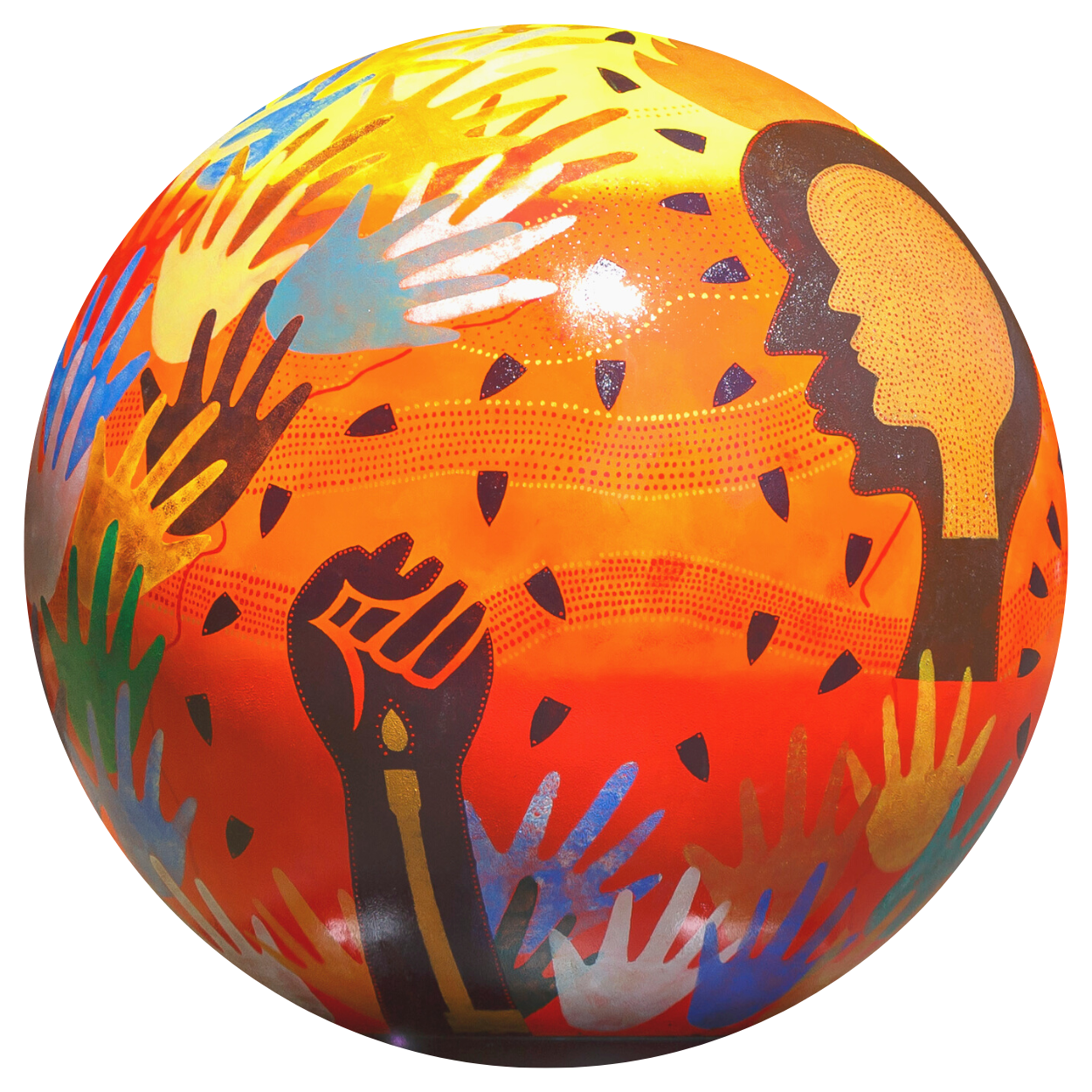
Earth\'s CradleMy globe was influenced by the ancient roots of Mother Africa, and their legacy, spiritual roots and ancestral connections to the cosmos. My artwork engaged though placemaking with the key elements such as the heads, the hands, and the movement on the globe. Since the beginning of humanity'... |
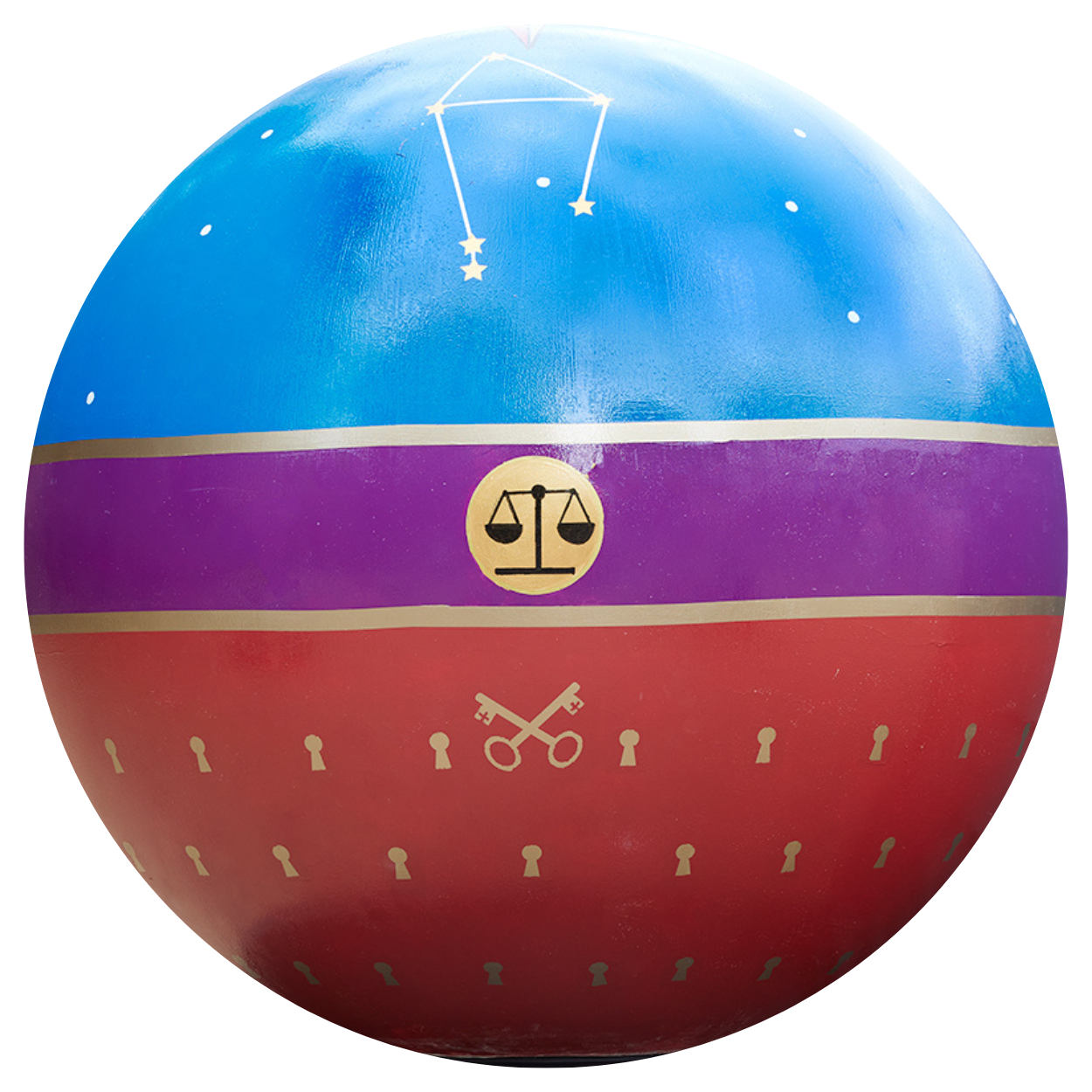
The Church & Slavery: Within Its OrbitThis globe represents the church’s central involvement in slavery. It kept enslaved people in bondage when it could have freed them. The profit from slavery also contributed to the church, funding buildings that represent the legacy of the institution today. |
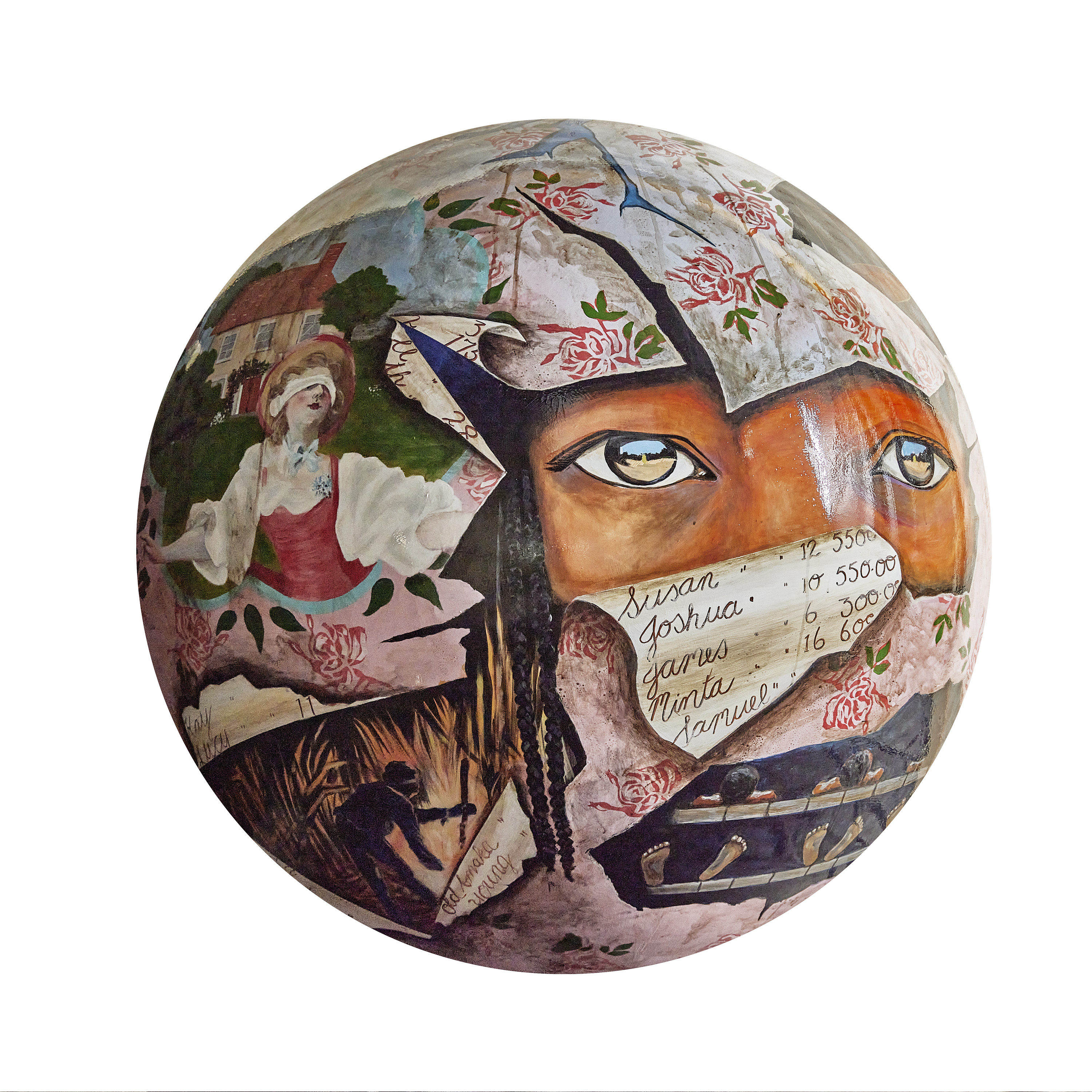
The Truth Will OutMy work can be described as Social Realism. I am particularly interested in depicting the effects of socio-political events which adversely impact the lives of so many people. Children and women often find themselves the innocent victims of war. From the plight of children affected by apart... |
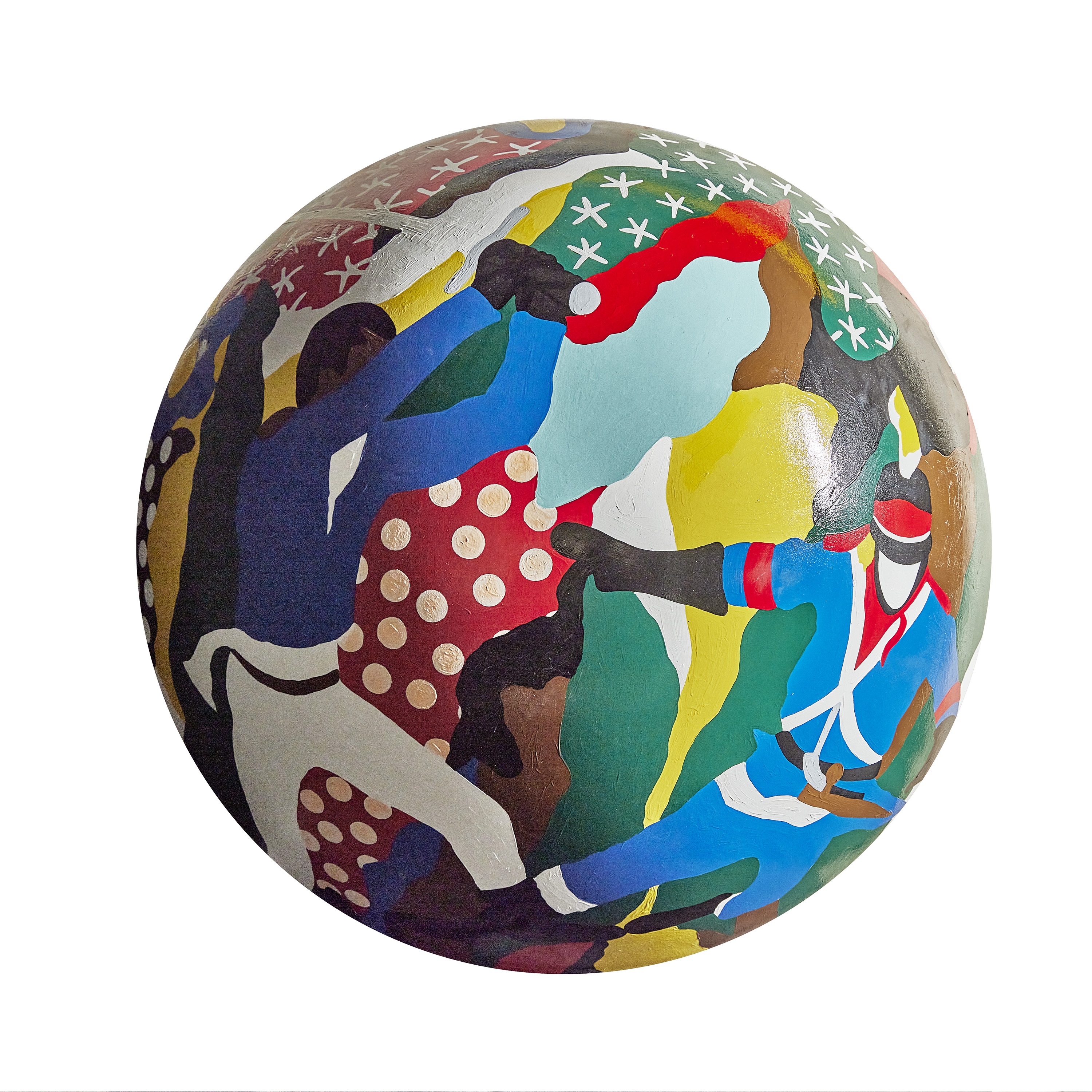
Hidden GemsMy practice – which incorporates installations, sculpture, painting and street art – challenges social narratives, explores cultural origins, history, and political themes. My work explores history and its relevance to modern socie... |
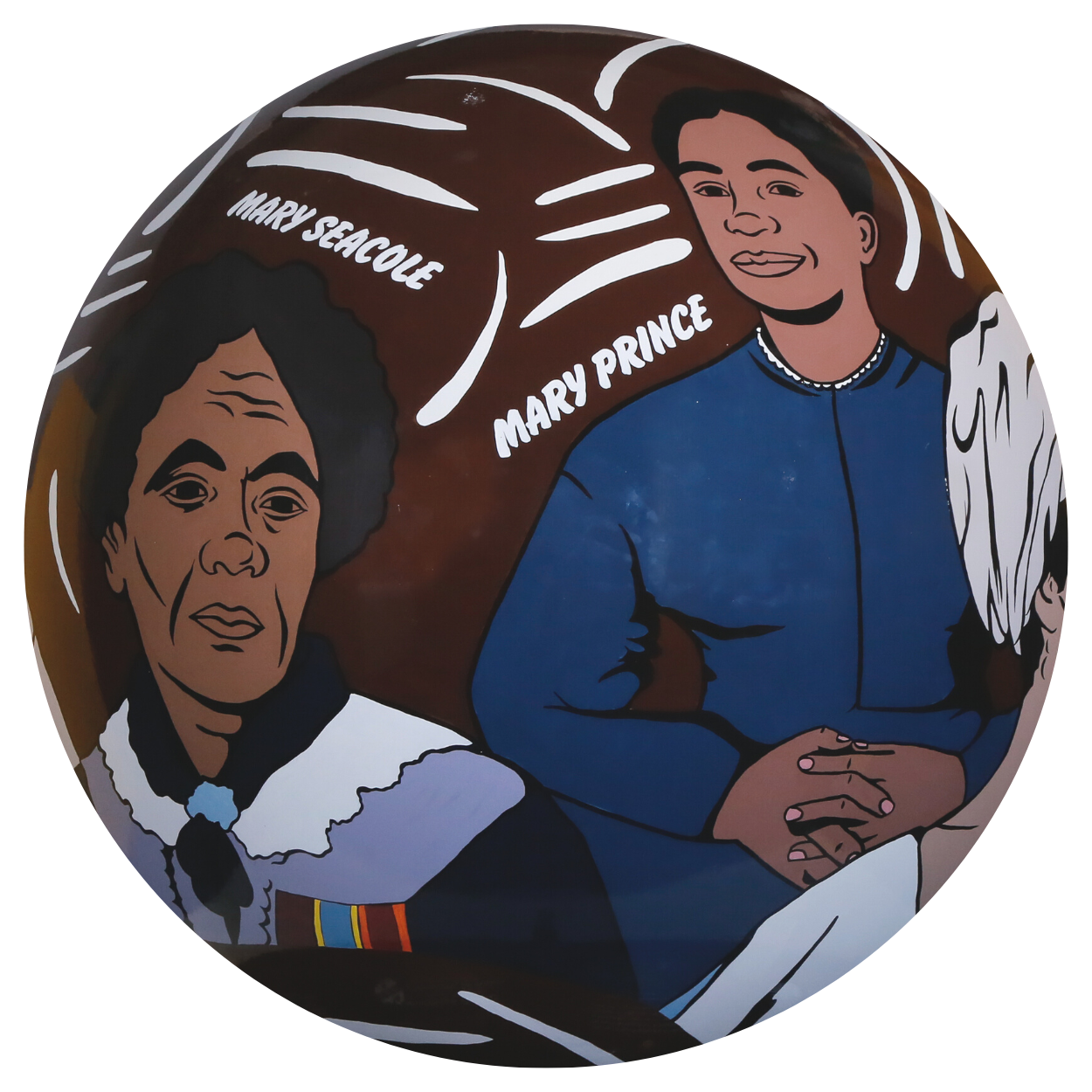
Abolition & Emancipation / LegacyMy globe features an artistic interpretation of depictions of Black women in pivotal times throughout this period of history – women whose voices and stories have been lost or overshadowed completely. Stories that have been passed down through oral history and become... |
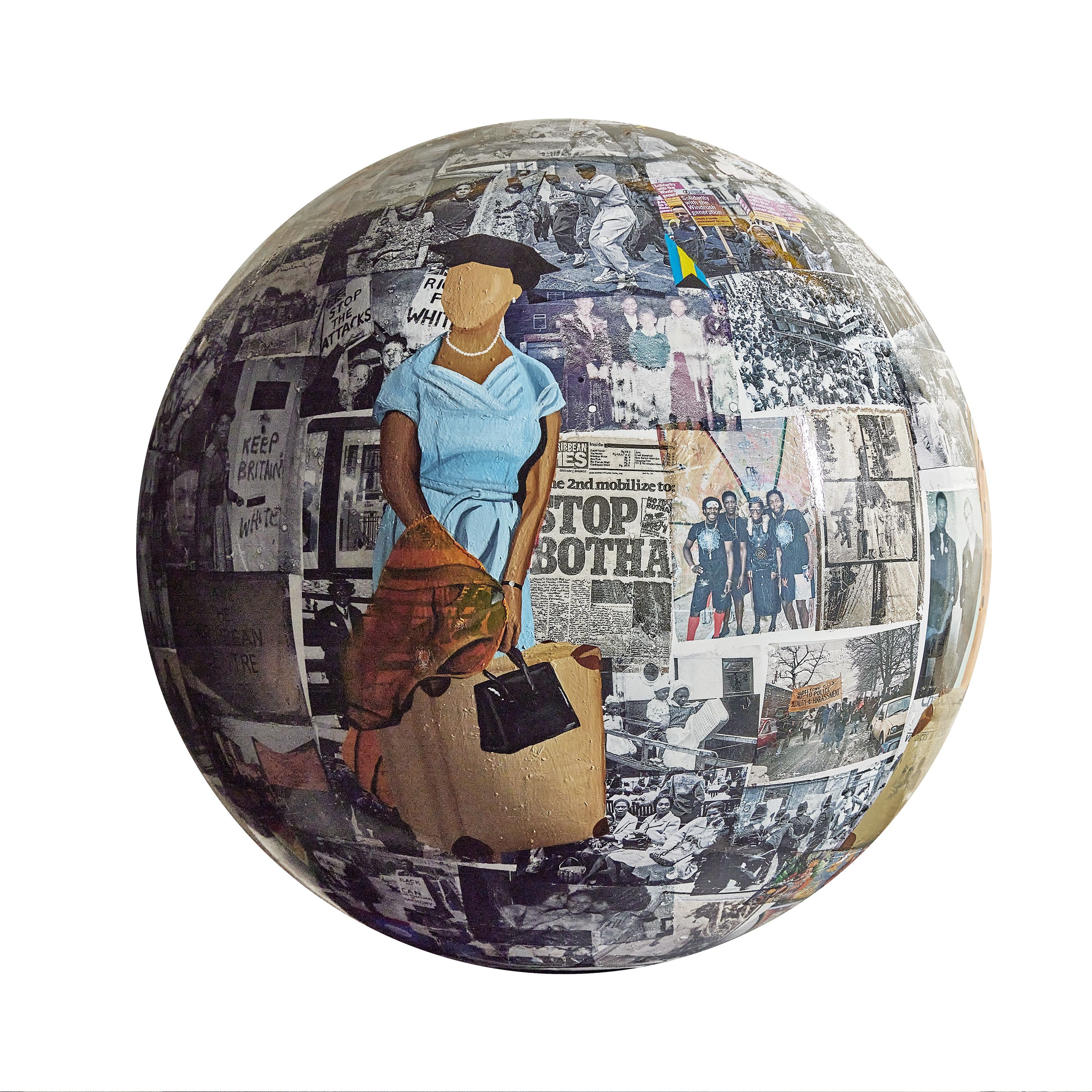
Weh You From? Weh Yuh A Go?As the granddaughter of a woman who was part of the generation of West Indians who answered Britain's call for workers, this globe’s title, Weh Yuh From? Weh Yuh A Go?, seeks to understand what my ancestor and others like her went through, in their migration to Britain. |
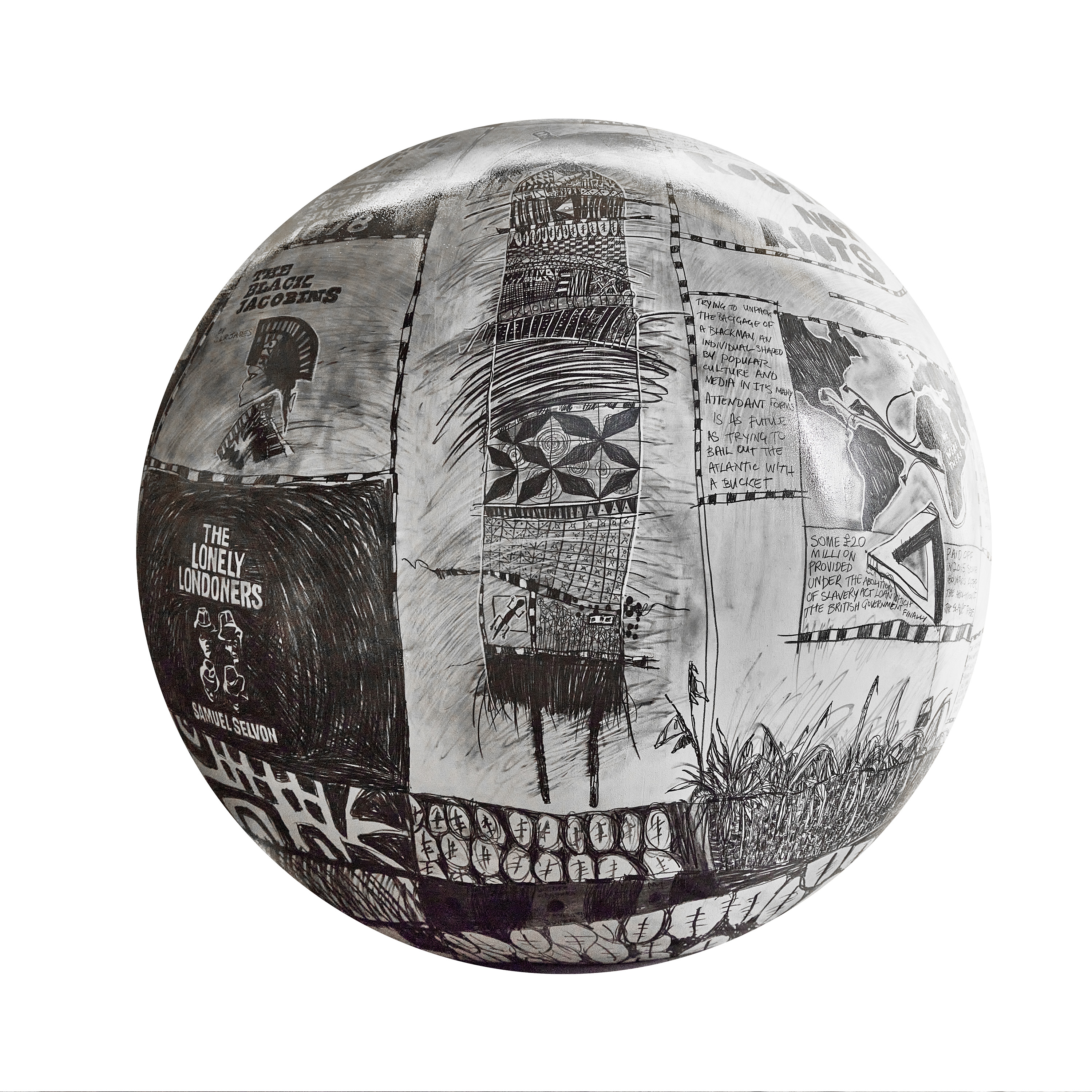
A Complex Triangle IndeedThe work can be described as a mind map of different complex historical trajectories, with reflections in the present and the contemporary, as well as personal musings – I am after all a member of a diaspora of a diaspora of a diaspora &nda... |

Still We StriveMy globe reflects on and documents my life and my work as an artist, writer, campaigner and activist with Trinidadian heritage and African roots, and the injustices our communities face today. It documents the struggle for racial justice through a visual diary. M... |

Falling Through The CracksThis globe design is painted to appear as though it is entirely made of complex rock formations. It represents the lasting legacy of the Transatlantic Trade in Enslaved Africans, with its chasms, cracks and crevices. These imperfections represent the scarring damage not just on the surface,... |
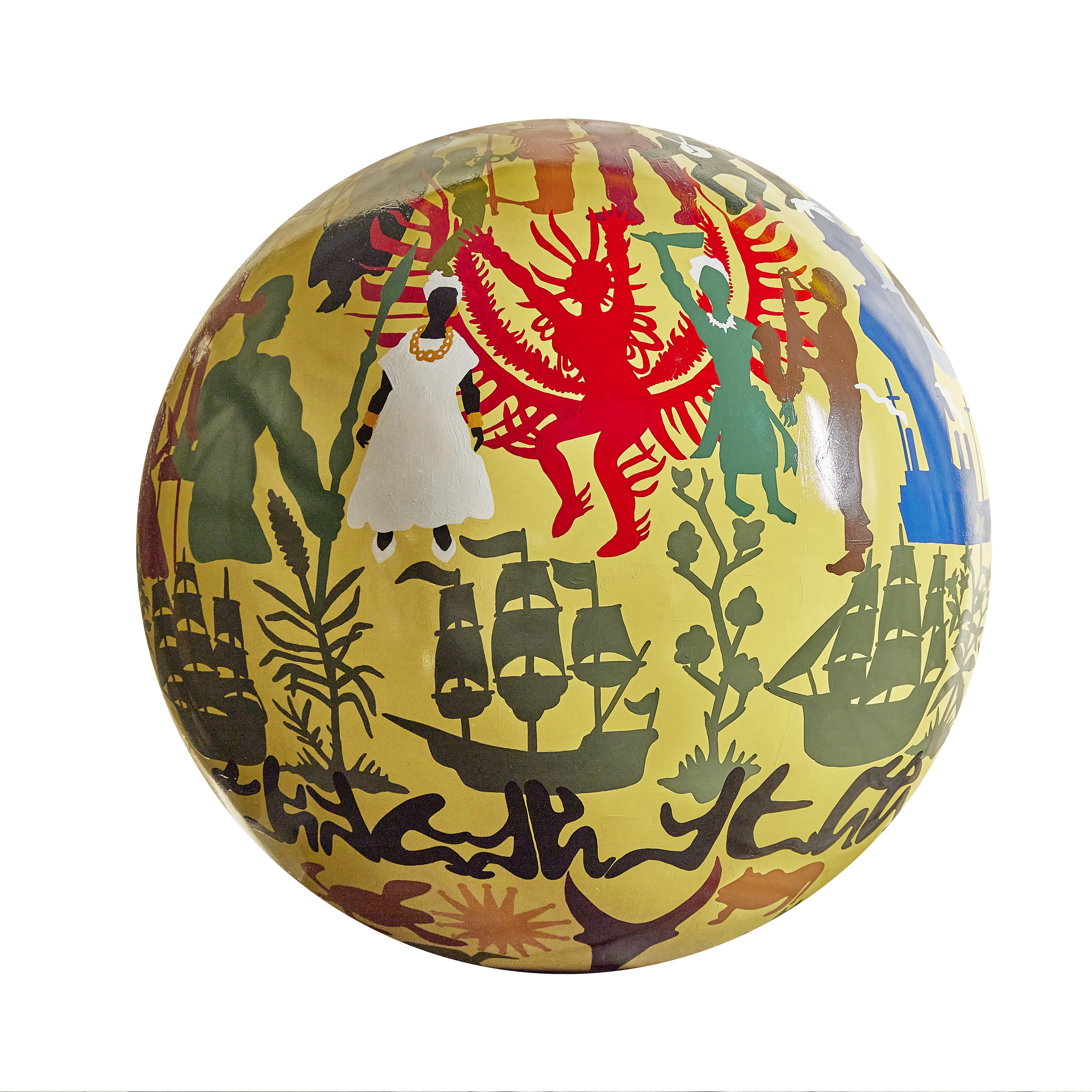
Like The SunMaya Angelou’s poem – which this theme’s title paraphrases – tells of courage, hope and joy, despite the burden history puts upon the people of the African diaspora. I chose this theme, therefore, because it echoes a de... |

Tributaries Of KnowledgeTributaries Of Knowledge celebrates the legacy of Kenyan environmental activist Wangari Maathai and the seeds she planted during a remarkable lifetime. Maathai was tenacious and a pioneer. She thought globally and acted locally, leading the fight against environmental degr... |
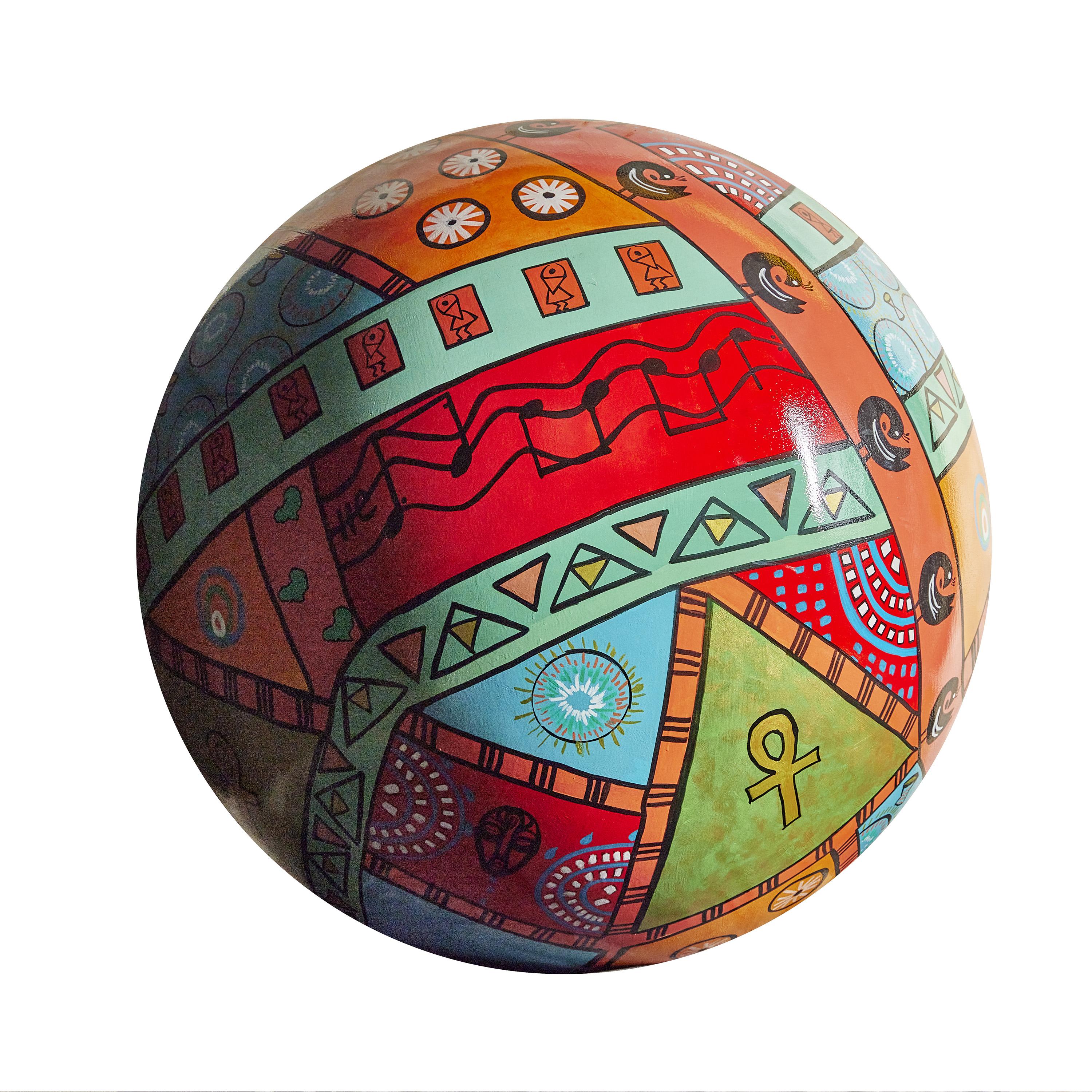
Spirit Of The DiasporaFor the theme Expanding Soul I thought about all the things that Africa has given the world; but there were so many elements it was impossible to include everything on one globe! I decided to focus on music, the geometric patterns of African cloth that have influenced so m... |

… And Into The FutureThis globe looks to recognise how even when faced with adversity, cooperation and sacrifice within the Black community has led to the conquering of obstacles and barriers throughout history. From our darkest times in slavery and colonialism, to problems faced today, people of African descen... |
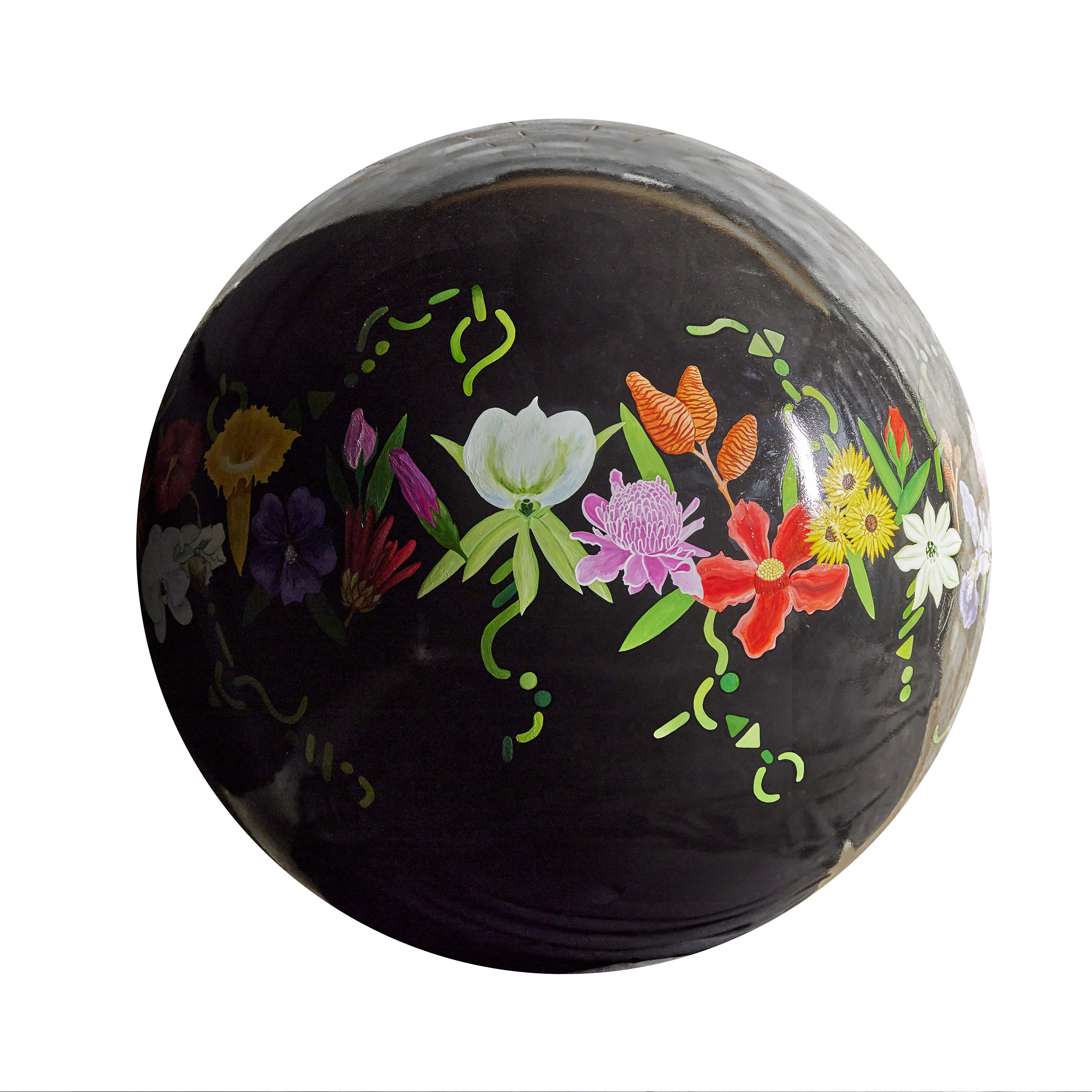
Ecology of ExistenceOur globe takes the power, resistance and beauty of Black people and celebrates them in a unified design. Painted onto a black background, the 54 national flowers of each African country are positioned across the equator of the globe, alongside a green, chain-inspired, vine motif. This desi... |
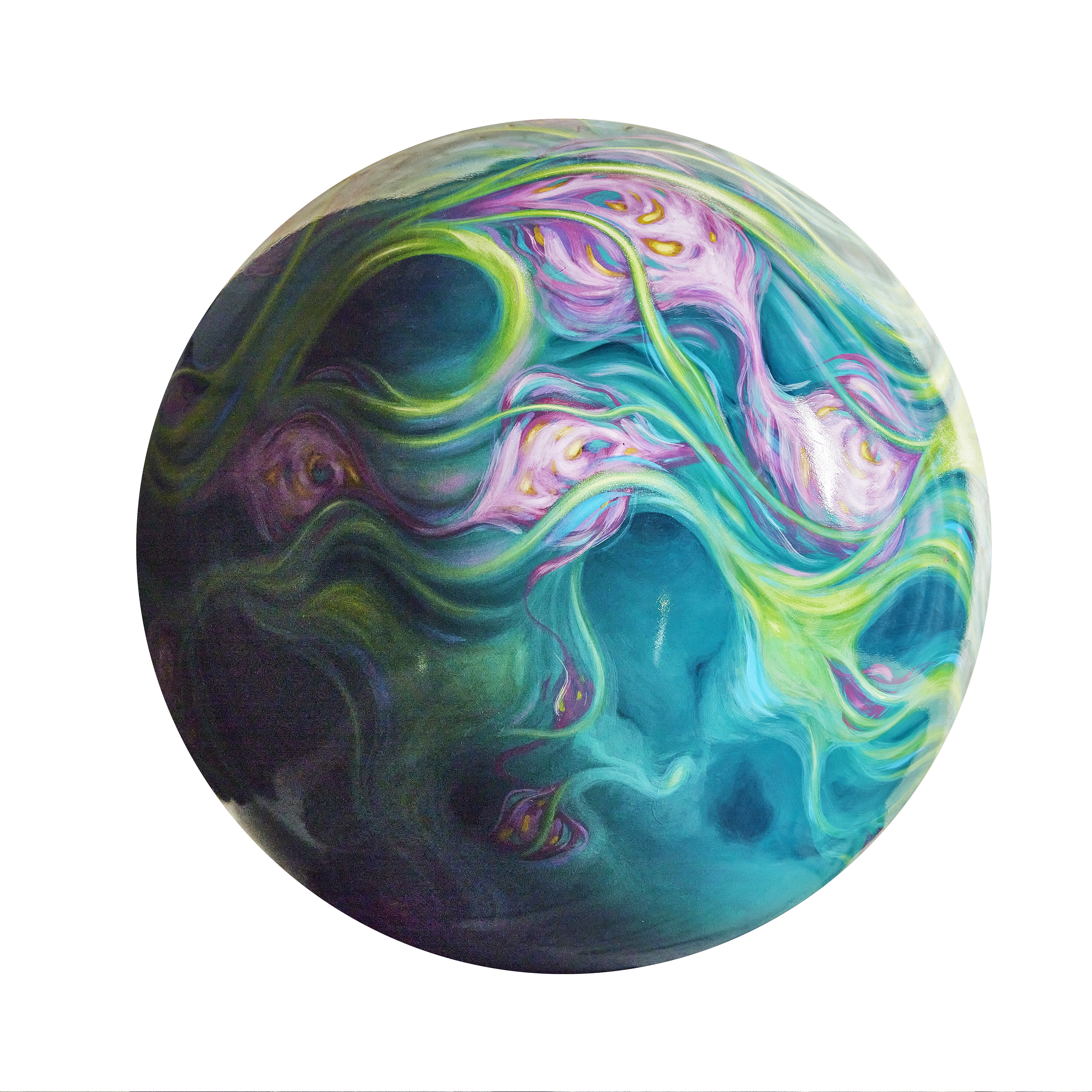
From Roots To FruitAfter exploring the theme to which I am responding, Reimagine The Future, several keywords and phrases presented themselves to me; from roots to fruit; vitality; courage; fluidity; unwavering; and the divine feminine. All of which I felt are emblematic of the tra... |


| Swansea Castle |
Mfikela's design responds to the theme ‘Mother Africa’, which explores the richness and reality of Africa before the Transatlantic Trade in Enslaved Africans; the impact of the Transatlantic Trade in Enslaved Africans and European colonialism on Africa; and considers and celebrates Africa’s present and future.
I have painted my opinion of the greatness and glory of Mama Africa. I have endeavoured to include all regions of Africa, their cultures and their traditions, their customs and their natural resources. I carefully chose my colours to reflect the warmth of the African sun and I adorned my piece with some African symbols that show the endurance and greatness of Africa. I also use symbols from some languages in West Africa that existed long before the Transatlantic Trade in Enslaved Africans and colonisation.
The African savanna and her giants like the lion, elephant, giraffes and ostrich are also represented. Egypt has an established place in world civilisation, philosophy, culture and architecture. I did not forget the sphinx, the pyramids of Giza and I simulated Ramesses the Great. I used acrylic paint on the globe and added to the work later with poster colours.
Mfikela Jean Samuel is a Contemporary Artist (Painter) from Africa but now resides permanently in North Wales. He has travelled across Europe and Africa and his paintings have been exhibited throughout the world in both public and private galleries and other cultural events. His primary medium is oil colours/acrylic on canvas. His source of inspiration comes from his African Cultural Heritage especially the ways of life of his lineage both past and present. His brush strokes are bold with vibrant colours, depicting the vast richness of his diverse cultural story and heritage. He also uses historical and contemporary themes where fact, imagination and illusions are brilliantly depicted. The great sceneries and landscapes of North Wales have captured his attention as seen in some of his works. As an Artist of his time, he has recently explored contemporary issues like Climate Change, Artificial Intelligence and Crypto Currency in his newest Art Forms.
Mfikela's design responds to the theme ‘Mother Africa’, which explores the richness and reality of Africa before the Transatlantic Trade in Enslaved Africans; the impact of the Transatlantic Trade in Enslaved Africans and European colonialism on Africa; and considers and celebrates Africa’s present and future.
I have painted my opinion of the greatness and glory of Mama Africa. I have endeavoured to include all regions of Africa, their cultures and their traditions, their customs and their natural resources. I carefully chose my colours to reflect the warmth of the African sun and I adorned my piece with some African symbols that show the endurance and greatness of Africa. I also use symbols from some languages in West Africa that existed long before the Transatlantic Trade in Enslaved Africans and colonisation.
The African savanna and her giants like the lion, elephant, giraffes and ostrich are also represented. Egypt has an established place in world civilisation, philosophy, culture and architecture. I did not forget the sphinx, the pyramids of Giza and I simulated Ramesses the Great. I used acrylic paint on the globe and added to the work later with poster colours.
Mfikela Jean Samuel is a Contemporary Artist (Painter) from Africa but now resides permanently in North Wales. He has travelled across Europe and Africa and his paintings have been exhibited throughout the world in both public and private galleries and other cultural events. His primary medium is oil colours/acrylic on canvas. His source of inspiration comes from his African Cultural Heritage especially the ways of life of his lineage both past and present. His brush strokes are bold with vibrant colours, depicting the vast richness of his diverse cultural story and heritage. He also uses historical and contemporary themes where fact, imagination and illusions are brilliantly depicted. The great sceneries and landscapes of North Wales have captured his attention as seen in some of his works. As an Artist of his time, he has recently explored contemporary issues like Climate Change, Artificial Intelligence and Crypto Currency in his newest Art Forms.


Gayani's design responds to the theme ‘Mother Africa’, which explores the richness and reality of Africa before the Transatlantic Trade in Enslaved Africans; the impact of the Transatlantic Trade in Enslaved Africans and European colonialism on Africa; and considers and celebrates Africa’s present and future.
Much ancient knowledge about the healthgiving and healing power of plants comes from Africa. This knowledge was passed on from generation to generation, from continent to continent, to enable people to heal, survive and even connect with the sacred. The history of these plants that are now known and grown throughout the world is entwined with the Transatlantic Trade in Enslaved Africans.
If the enslaved became ill in the horrendous conditions on the ships that transported them from Africa to the Americas, they would not receive medical treatment and risked being abandoned to the sea – thrown overboard – even before they died. Knowing this, the enslaved learned to look after their health by hiding medicinal leaves and seeds in their clothes or hair, to which that they could add to water or chew on to get better on the voyage.
My globe shows many of these plants and flowers. Coca from the kola nut – which acted as a sedative; cannabis sticks and leaves which were bitten or chewed when ill, and the aloe vera leaf which could be bitten to satiate feelings of hunger when there was no food.
Ocra and bitter melon all come from Africa and are still today used as herbal medicines worldwide. The eggplant – also originally from Africa – has medicinal properties and is now grown all over the world in hybrid species. The peacock flower is actually very tiny, but its impact in the Caribbean is very large – it is still drunk regularly to maintain and improve health – so it is shown much enlarged on my globe. Pods from the cotton bushes, one of the most profitable crops produced by enslaved labour in America, are also included - raw cotton was exported to be processed in Britain and then sold all over the world.
The background of the globe is sugar cane; not native to Africa but grown in the Caribbean with enslaved labour and this is symbolised by the chains amongst the plants.
In modern societies, our access to medicine is often restricted by corporate monopolies – we have lost touch with these natural and ancient healing powers. The image of Justicea in the centre of the globe holding a very unbalanced scale and without a sword – her power has been taken away – represents this.
The gold paint on top of the globe represents the natural resources of Africa’s gold and botanical treasures before it was plundered.
I have painted this globe in a naïve, childlike style as a tribute to my parents, both of whom I lost very recently: my mother was a primary school teacher and I often drew artwork for her classes, and my father was an established artists and sculptor.
Gayani lives in Birmingham and is an artist, vegan chef and ethical floral designer originally from Sri Lanka who has lived in the UK for 27 years. Her work is based on nature, especially plants and flowers. She has been a Wild in Art artist since 2017. She has been glass painting for 26 years and is preparing to have an exhibition to celebrate 4,000 pieces of glass art that are from her collection. She uses art as therapy to help others (and herself) to overcome grief and improve mental health.
Gayani's design responds to the theme ‘Mother Africa’, which explores the richness and reality of Africa before the Transatlantic Trade in Enslaved Africans; the impact of the Transatlantic Trade in Enslaved Africans and European colonialism on Africa; and considers and celebrates Africa’s present and future.
Much ancient knowledge about the healthgiving and healing power of plants comes from Africa. This knowledge was passed on from generation to generation, from continent to continent, to enable people to heal, survive and even connect with the sacred. The history of these plants that are now known and grown throughout the world is entwined with the Transatlantic Trade in Enslaved Africans.
If the enslaved became ill in the horrendous conditions on the ships that transported them from Africa to the Americas, they would not receive medical treatment and risked being abandoned to the sea – thrown overboard – even before they died. Knowing this, the enslaved learned to look after their health by hiding medicinal leaves and seeds in their clothes or hair, to which that they could add to water or chew on to get better on the voyage.
My globe shows many of these plants and flowers. Coca from the kola nut – which acted as a sedative; cannabis sticks and leaves which were bitten or chewed when ill, and the aloe vera leaf which could be bitten to satiate feelings of hunger when there was no food.
Ocra and bitter melon all come from Africa and are still today used as herbal medicines worldwide. The eggplant – also originally from Africa – has medicinal properties and is now grown all over the world in hybrid species. The peacock flower is actually very tiny, but its impact in the Caribbean is very large – it is still drunk regularly to maintain and improve health – so it is shown much enlarged on my globe. Pods from the cotton bushes, one of the most profitable crops produced by enslaved labour in America, are also included - raw cotton was exported to be processed in Britain and then sold all over the world.
The background of the globe is sugar cane; not native to Africa but grown in the Caribbean with enslaved labour and this is symbolised by the chains amongst the plants.
In modern societies, our access to medicine is often restricted by corporate monopolies – we have lost touch with these natural and ancient healing powers. The image of Justicea in the centre of the globe holding a very unbalanced scale and without a sword – her power has been taken away – represents this.
The gold paint on top of the globe represents the natural resources of Africa’s gold and botanical treasures before it was plundered.
I have painted this globe in a naïve, childlike style as a tribute to my parents, both of whom I lost very recently: my mother was a primary school teacher and I often drew artwork for her classes, and my father was an established artists and sculptor.
Gayani lives in Birmingham and is an artist, vegan chef and ethical floral designer originally from Sri Lanka who has lived in the UK for 27 years. Her work is based on nature, especially plants and flowers. She has been a Wild in Art artist since 2017. She has been glass painting for 26 years and is preparing to have an exhibition to celebrate 4,000 pieces of glass art that are from her collection. She uses art as therapy to help others (and herself) to overcome grief and improve mental health.


Roy's design responds to the theme ‘The Reality of Being Enslaved’, which makes real the experience of those people who were enslaved, from their capture, captivity and voyage to lives and deaths enslaved in different contexts, places and generations.
I have always been very moved by the painting The Slave Ship by J.M.W. Turner. In his painting you see a ship in the background and hands rising out of the tumultuous waves. Turner exhibited this painting at The Royal Academy of Arts in 1840 and it was originally called Slavers Throwing overboard the Dead and Dying—Typhon coming on. It is speculated that Turner had read about the Zong ship. It haunted me, and possibly him, that after throwing enslaved people overboard due to a lack of drinking water, an insurance claim was placed on the bodies from the Zong. I was and still am deeply impacted by the treatment of humans as cargo.
In my piece I paint what happened in this scene below the surface of the water. I believe it's really important that we as a society are clear and honest about how horrific the reality of this history was and is. The hands in Turners piece were more than hands. They were humans. Mothers, fathers, sons, daughters, lovers.
I name most of my work after songs. I have named this piece How Deep Is Your Love?, after the song. It is centred around a couple holding each other as they sink. I imagined how the people who were sent to their death would have comforted each other in these last moments. I wanted to show their humanity in the face of such inhumanity.
Roy was born in Nottingham City Centre in 1958. The son of a long Distant Lorry Driver and a Lace Maker, cobbled street were still the norm. Roy’s most recent murals have been painted in Father Hudson’s Care Homes in Coleshill. With further work commissioned.
Roy's design responds to the theme ‘The Reality of Being Enslaved’, which makes real the experience of those people who were enslaved, from their capture, captivity and voyage to lives and deaths enslaved in different contexts, places and generations.
I have always been very moved by the painting The Slave Ship by J.M.W. Turner. In his painting you see a ship in the background and hands rising out of the tumultuous waves. Turner exhibited this painting at The Royal Academy of Arts in 1840 and it was originally called Slavers Throwing overboard the Dead and Dying—Typhon coming on. It is speculated that Turner had read about the Zong ship. It haunted me, and possibly him, that after throwing enslaved people overboard due to a lack of drinking water, an insurance claim was placed on the bodies from the Zong. I was and still am deeply impacted by the treatment of humans as cargo.
In my piece I paint what happened in this scene below the surface of the water. I believe it's really important that we as a society are clear and honest about how horrific the reality of this history was and is. The hands in Turners piece were more than hands. They were humans. Mothers, fathers, sons, daughters, lovers.
I name most of my work after songs. I have named this piece How Deep Is Your Love?, after the song. It is centred around a couple holding each other as they sink. I imagined how the people who were sent to their death would have comforted each other in these last moments. I wanted to show their humanity in the face of such inhumanity.
Roy was born in Nottingham City Centre in 1958. The son of a long Distant Lorry Driver and a Lace Maker, cobbled street were still the norm. Roy’s most recent murals have been painted in Father Hudson’s Care Homes in Coleshill. With further work commissioned.


| Lovell Park, North Lane |
Mussarat's design responds to the theme ‘The Reality of Being Enslaved’, which makes real the experience of those people who were enslaved, from their capture, captivity and voyage to lives and deaths enslaved in different contexts, places and generations.
My globe was influenced by the ancient roots of Mother Africa, and their legacy, spiritual roots and ancestral connections to the cosmos. My artwork engaged though placemaking with the key elements such as the heads, the hands, and the movement on the globe. Since the beginning of humanity's ability to travel across the seas, Africa has always captured the imagination. But this led to the murder and enslavement of a continent – fragmenting each country – by white men who distorted the purity, history and culture of Africa itself; bringing death, dis-ease, and fracturing societies instead of acknowledging the continent’s inherent beauty.
The hands represent the countries, nations of Africa, and show the multiculturalism and the rich tapestry of people who live there. The heads represent the powerful lineage of women and men whose roots can be traced through their ancestry. The guns represent power –when you can't control a nation, guns are used. The bullets represent the brutalisation of a nation; for the white man's greed how much blood has been shed? Here you can see the guns have a double element – the candle flames – which represent peace after conflict.
The head inside a head represents recognition of the ancestral links, connecting into a deep inner wisdom that is intergenerational, passed down by mother to child. Both heads represent the passing on of ancestral wisdom of the elders making a connection to the younger generations who will take up the mantle and champion the rights of Mother Africa; a call to its warriors of wisdom, always seeking the flame of truth.
The flame represents innate spiritual wisdom, truth, justice, harmony and peace – burning eternally for Mother Africa.
Mussarat Rahman is a community artist and poet. For the last few years she has been experimenting with 3D art and installations with a variety of community groups and festivals. She runs social action projects, and delivers community programmes with different communities, and in particular with refugees and asylum seekers. Her work addresses themes of migration and movement, religion, spirituality, materialism, politics, and gender. She designs projects around local and global issues which affect society and particularly affect communities. Her projects are designed to create a reaction and be interactive to engage audiences.
Mussarat's design responds to the theme ‘The Reality of Being Enslaved’, which makes real the experience of those people who were enslaved, from their capture, captivity and voyage to lives and deaths enslaved in different contexts, places and generations.
My globe was influenced by the ancient roots of Mother Africa, and their legacy, spiritual roots and ancestral connections to the cosmos. My artwork engaged though placemaking with the key elements such as the heads, the hands, and the movement on the globe. Since the beginning of humanity's ability to travel across the seas, Africa has always captured the imagination. But this led to the murder and enslavement of a continent – fragmenting each country – by white men who distorted the purity, history and culture of Africa itself; bringing death, dis-ease, and fracturing societies instead of acknowledging the continent’s inherent beauty.
The hands represent the countries, nations of Africa, and show the multiculturalism and the rich tapestry of people who live there. The heads represent the powerful lineage of women and men whose roots can be traced through their ancestry. The guns represent power –when you can't control a nation, guns are used. The bullets represent the brutalisation of a nation; for the white man's greed how much blood has been shed? Here you can see the guns have a double element – the candle flames – which represent peace after conflict.
The head inside a head represents recognition of the ancestral links, connecting into a deep inner wisdom that is intergenerational, passed down by mother to child. Both heads represent the passing on of ancestral wisdom of the elders making a connection to the younger generations who will take up the mantle and champion the rights of Mother Africa; a call to its warriors of wisdom, always seeking the flame of truth.
The flame represents innate spiritual wisdom, truth, justice, harmony and peace – burning eternally for Mother Africa.
Mussarat Rahman is a community artist and poet. For the last few years she has been experimenting with 3D art and installations with a variety of community groups and festivals. She runs social action projects, and delivers community programmes with different communities, and in particular with refugees and asylum seekers. Her work addresses themes of migration and movement, religion, spirituality, materialism, politics, and gender. She designs projects around local and global issues which affect society and particularly affect communities. Her projects are designed to create a reaction and be interactive to engage audiences.


Gregory’s design responds to the theme ‘Stolen Legacy: The Rebirth of a Nation’, which brings to life how Britain was transformed and enriched as a result of the Transatlantic Trade in Enslaved Africans and the free labour of the enslaved. It explores the legacy of the Transatlantic Trade in Enslaved Africans in building the financial and trading power of Britain; strengthening the Church and the might of universities; and establishing dynastic influence and power.
This globe represents the church’s central involvement in slavery. It kept enslaved people in bondage when it could have freed them. The profit from slavery also contributed to the church, funding buildings that represent the legacy of the institution today.
This globe has been painted with flat colours: gold highlights the profit, blue is the Atlantic ocean, whilst the purple band represents the church, surrounding and arching over the globe. The constellations represent the imbalance of justice for the enslaved and the trade routes navigated by the ships. The compass points to the four poles; injustice, plantation, church and shipping.
An artist working predominantly in printmaking and illustration, Gregory works in traditional lino prints and digital illustration and is inspired by forms found in architecture and nature.
Gregory’s design responds to the theme ‘Stolen Legacy: The Rebirth of a Nation’, which brings to life how Britain was transformed and enriched as a result of the Transatlantic Trade in Enslaved Africans and the free labour of the enslaved. It explores the legacy of the Transatlantic Trade in Enslaved Africans in building the financial and trading power of Britain; strengthening the Church and the might of universities; and establishing dynastic influence and power.
This globe represents the church’s central involvement in slavery. It kept enslaved people in bondage when it could have freed them. The profit from slavery also contributed to the church, funding buildings that represent the legacy of the institution today.
This globe has been painted with flat colours: gold highlights the profit, blue is the Atlantic ocean, whilst the purple band represents the church, surrounding and arching over the globe. The constellations represent the imbalance of justice for the enslaved and the trade routes navigated by the ships. The compass points to the four poles; injustice, plantation, church and shipping.
An artist working predominantly in printmaking and illustration, Gregory works in traditional lino prints and digital illustration and is inspired by forms found in architecture and nature.


| St Mary's Square |
Hazel's design responds to the theme ‘A Complex Triangle’, which explores the complexity of Britain’s relationship with Africa, the Americas and the Caribbean across generations, and the legacy of the Transatlantic Trade in Enslaved Africans on the UK’s role and reputation in the world.
My work can be described as Social Realism. I am particularly interested in depicting the effects of socio-political events which adversely impact the lives of so many people. Children and women often find themselves the innocent victims of war. From the plight of children affected by apartheid to the ongoing refugee crisis, especially the current context of Europe and the United Kingdom.
I am intrigued by the juxtaposition of colonial imagery with that of cultures which have lost so much of their own identity as a consequence of centuries of global European expansion. I work in a variety of mediums, including screen printing, drawing and painting in oils, acrylics and watercolours. Drawing inspiration from life, art galleries, museums, literature, news, and social media is important in the creation of my mostly representational works which aim to present recognisable imagery that can appear deceptively nostalgic, but carry a serious message.
The World Reimagined project is a perfect platform of expression for a subject that is already close to my heart. As a white person born in Zambia (Northern Rhodesia) in 1963, who grew up in South Africa in the apartheid era, from an early age I have been conscious of social injustices. Apartheid, a result of colonialism, has fed into my artistic development. The Transatlantic Trade in Enslaved Africans is inextricably tied up with the cruel domination and, in some cases, near annihilation of indigenous peoples like the Khoisan.
My design covers more than one World Reimagined theme, but best represents, A Complex Triangle. The colonial wallpaper is a metaphor for centuries of denial and cover ups. A figure from Jean-Honore Fragonard’s rococo painting, ‘Blind Man’s Bluff’ (1750-52) is depicted on the paper signifying the blindness, selective or otherwise, of many western people to slavery in the past and the effects of its present-day legacy. The gradual disintegration of Empire slowly reveals more and more truths which can no longer be concealed – the truth will out.
Hazel Blue is a South African artist currently living in Glasgow, Scotland. Born in Zambia (Northern Rhodesia) in 1963, she grew up in Durban, KwaZulu Natal. Growing up in the climate of massive political and social change, Hazel is highly conscious of having had a privileged life as a white South African. Hazel later taught at Johannesburg Art, Ballet, Drama, and Music School in the five years preceding the 1994 elections. It was a volatile time with marches by the ANC, Inkatha Freedom Party and AWB starting on the street outside the school. Hazel’s work “Going Home?” from 1992 depicts people on a bus with a child as the focal point. The title refers to the violence that had erupted in Townships at this time. Hazel is currently working towards a MA in Arts Education. Her dissertation will investigate the teaching of Art History in Scottish Secondary Schools, interrogating the often Eurocentric perspective.
Hazel's design responds to the theme ‘A Complex Triangle’, which explores the complexity of Britain’s relationship with Africa, the Americas and the Caribbean across generations, and the legacy of the Transatlantic Trade in Enslaved Africans on the UK’s role and reputation in the world.
My work can be described as Social Realism. I am particularly interested in depicting the effects of socio-political events which adversely impact the lives of so many people. Children and women often find themselves the innocent victims of war. From the plight of children affected by apartheid to the ongoing refugee crisis, especially the current context of Europe and the United Kingdom.
I am intrigued by the juxtaposition of colonial imagery with that of cultures which have lost so much of their own identity as a consequence of centuries of global European expansion. I work in a variety of mediums, including screen printing, drawing and painting in oils, acrylics and watercolours. Drawing inspiration from life, art galleries, museums, literature, news, and social media is important in the creation of my mostly representational works which aim to present recognisable imagery that can appear deceptively nostalgic, but carry a serious message.
The World Reimagined project is a perfect platform of expression for a subject that is already close to my heart. As a white person born in Zambia (Northern Rhodesia) in 1963, who grew up in South Africa in the apartheid era, from an early age I have been conscious of social injustices. Apartheid, a result of colonialism, has fed into my artistic development. The Transatlantic Trade in Enslaved Africans is inextricably tied up with the cruel domination and, in some cases, near annihilation of indigenous peoples like the Khoisan.
My design covers more than one World Reimagined theme, but best represents, A Complex Triangle. The colonial wallpaper is a metaphor for centuries of denial and cover ups. A figure from Jean-Honore Fragonard’s rococo painting, ‘Blind Man’s Bluff’ (1750-52) is depicted on the paper signifying the blindness, selective or otherwise, of many western people to slavery in the past and the effects of its present-day legacy. The gradual disintegration of Empire slowly reveals more and more truths which can no longer be concealed – the truth will out.
Hazel Blue is a South African artist currently living in Glasgow, Scotland. Born in Zambia (Northern Rhodesia) in 1963, she grew up in Durban, KwaZulu Natal. Growing up in the climate of massive political and social change, Hazel is highly conscious of having had a privileged life as a white South African. Hazel later taught at Johannesburg Art, Ballet, Drama, and Music School in the five years preceding the 1994 elections. It was a volatile time with marches by the ANC, Inkatha Freedom Party and AWB starting on the street outside the school. Hazel’s work “Going Home?” from 1992 depicts people on a bus with a child as the focal point. The title refers to the violence that had erupted in Townships at this time. Hazel is currently working towards a MA in Arts Education. Her dissertation will investigate the teaching of Art History in Scottish Secondary Schools, interrogating the often Eurocentric perspective.


| Castle Park |
Oshii's design responds to the theme ‘Abolition & Emancipation’, which shares the story of the campaign for abolition, its key events, heroes and allies. It also lays bare the full, messy motivations and process of abolition, which were not as pure as often represented.
My practice – which incorporates installations, sculpture, painting and street art – challenges social narratives, explores cultural origins, history, and political themes. My work explores history and its relevance to modern society and examines subject matter that is often overlooked in contemporary western narratives.
I use a variety of practices and methods in my work, ranging from collage to sculpture, however the materials I use are determined by the subject matter itself. In 2D form, I paint large images onto pieces of paper and deconstruct them, using destruction as a form of creation, to produce layered, bold collages which question the way we understand the world and our society.
For my globe, Hidden Gems, I explore and share the unacknowledged histories of the many uprisings and rebellions that took place throughout the history of the Transatlantic Trade in Enslaved Africans. Using the colours found in the flags of the countries in which some of these events took place, I allude to Jamaica, Haiti & the USA in particular, where the largest, most notable and successful uprisings occurred. The image conveys shapes of enslaved peoples fighting for their freedom against their colonial oppressors and draws attention to the Haitian Revolution of 1791-1804, where the Black enslaved fought and defeated the French and British colonial armies, leading to Haitian independence in 1804; a transitional point in history.
This piece acknowledges and celebrates these events and their ongoing legacies and aims to broaden our understanding of our shared history and the Transatlantic Trade in Enslaved Africans.
Bristol-based, visual artist Oshii combines bold colours with layered compositions to a multi-disciplinary practice to produce fine art which challenges social narratives, explores social and political issues and evokes dialogue. He has had work featured in Tate Liverpool and The Venice Biennale and worked with brands such as Jack Daniel’s.
Oshii's design responds to the theme ‘Abolition & Emancipation’, which shares the story of the campaign for abolition, its key events, heroes and allies. It also lays bare the full, messy motivations and process of abolition, which were not as pure as often represented.
My practice – which incorporates installations, sculpture, painting and street art – challenges social narratives, explores cultural origins, history, and political themes. My work explores history and its relevance to modern society and examines subject matter that is often overlooked in contemporary western narratives.
I use a variety of practices and methods in my work, ranging from collage to sculpture, however the materials I use are determined by the subject matter itself. In 2D form, I paint large images onto pieces of paper and deconstruct them, using destruction as a form of creation, to produce layered, bold collages which question the way we understand the world and our society.
For my globe, Hidden Gems, I explore and share the unacknowledged histories of the many uprisings and rebellions that took place throughout the history of the Transatlantic Trade in Enslaved Africans. Using the colours found in the flags of the countries in which some of these events took place, I allude to Jamaica, Haiti & the USA in particular, where the largest, most notable and successful uprisings occurred. The image conveys shapes of enslaved peoples fighting for their freedom against their colonial oppressors and draws attention to the Haitian Revolution of 1791-1804, where the Black enslaved fought and defeated the French and British colonial armies, leading to Haitian independence in 1804; a transitional point in history.
This piece acknowledges and celebrates these events and their ongoing legacies and aims to broaden our understanding of our shared history and the Transatlantic Trade in Enslaved Africans.
Bristol-based, visual artist Oshii combines bold colours with layered compositions to a multi-disciplinary practice to produce fine art which challenges social narratives, explores social and political issues and evokes dialogue. He has had work featured in Tate Liverpool and The Venice Biennale and worked with brands such as Jack Daniel’s.


| Grove Place |
Parys' design responds to the theme ‘Reimagine the Future’, which gives us free rein to imagine the society we can create when we have a full understanding of our shared history; the place the UK can hold in the world when it acknowledges its past; and who we can be as people and a country when we give full dignity to all.
My globe features an artistic interpretation of depictions of Black women in pivotal times throughout this period of history – women whose voices and stories have been lost or overshadowed completely.
Stories that have been passed down through oral history and become folk tales – like Queen Nanny of the Maroons – and interpretations of lesser-known free Black women such as Joane Marya who was described as a 'black Moore' living in Bristol during the seventeenth century. How did the lives of women like these women impact attitudes towards abolition and what did emancipation look like for women living through slavery?
Learning the legacy of these women gives us no choice but to rethink the roles of Black women, and how their lives and voices impacted the fight for freedom, as well as the legacy of their lives.
What more is there for us to uncover and how will this reshape how we tell the story of emancipation? How can our learning from these stories impact the world today?
Award-winning contemporary digital illustrator based in Bristol, UK. I create Pop art with a modern edge. My work has been commissioned for a collaborative project with Banksy, I had my first solo exhibition in Amsterdam in 2018/2019 and I have been commissioned by brands such as Nike, Footlocker, Facebook, BBC, gal-dem and more.
Parys' design responds to the theme ‘Reimagine the Future’, which gives us free rein to imagine the society we can create when we have a full understanding of our shared history; the place the UK can hold in the world when it acknowledges its past; and who we can be as people and a country when we give full dignity to all.
My globe features an artistic interpretation of depictions of Black women in pivotal times throughout this period of history – women whose voices and stories have been lost or overshadowed completely.
Stories that have been passed down through oral history and become folk tales – like Queen Nanny of the Maroons – and interpretations of lesser-known free Black women such as Joane Marya who was described as a 'black Moore' living in Bristol during the seventeenth century. How did the lives of women like these women impact attitudes towards abolition and what did emancipation look like for women living through slavery?
Learning the legacy of these women gives us no choice but to rethink the roles of Black women, and how their lives and voices impacted the fight for freedom, as well as the legacy of their lives.
What more is there for us to uncover and how will this reshape how we tell the story of emancipation? How can our learning from these stories impact the world today?
Award-winning contemporary digital illustrator based in Bristol, UK. I create Pop art with a modern edge. My work has been commissioned for a collaborative project with Banksy, I had my first solo exhibition in Amsterdam in 2018/2019 and I have been commissioned by brands such as Nike, Footlocker, Facebook, BBC, gal-dem and more.


Please note this Globe will join the others on the Town Hall steps on the 10 November 2022.
Jioni's design responds to the theme ‘A Complex Triangle’, which explores the complexity of Britain’s relationship with Africa, the Americas and the Caribbean across generations, and the legacy of the Transatlantic Trade in Enslaved Africans on the UK’s role and reputation in the world.
As the granddaughter of a woman who was part of the generation of West Indians who answered Britain's call for workers, this globe’s title, Weh Yuh From? Weh Yuh A Go?, seeks to understand what my ancestor and others like her went through, in their migration to Britain.
This globe is a personal response to reflecting thoughtfully and broadly on the British Caribbean history which pays homage to the Windrush generation, instilling a more profound sense of empowerment to what our forebears achieved in paving the way for the future generations, including my own. Having these discussions around the Windrush brings further details into their stories which can be passed onto future generations.
Maya Angelou wrote "You can't know where you are going until you know where you have been." This has been shortened in a Caribbean dialect which has created the title.
The portrait paintings over the collage pay tribute to the Black womxn as they are overlooked when discussing our history, dealing with the triple oppression of racism, sexism, and classism. They represent the grandmother, mother, aunties, sisters, daughters, and others dear to us.
The collage of photos was sourced from archives, and the internet and collected from the Leeds and Liverpool Caribbean community. They seek to highlight the Black British experience and culture containing photos from the 1950s to 1990s, covering the arrival, daily life, cultural events, and the hostile environment.
A special thank you to all who sent in their family photographs to be used to make this globe come alive, and especially to Max Farrar who has photographed the Leeds Chapeltown community since the 1970s.
Jioni Warner is an artist born in Leeds. She is currently in the final year of her BA at Staffordshire University. From a young age, Warner developed a passion for art. She describes herself as a mixed media painter but has experimented with lots of materials over the years.
Please note this Globe will join the others on the Town Hall steps on the 10 November 2022.
Jioni's design responds to the theme ‘A Complex Triangle’, which explores the complexity of Britain’s relationship with Africa, the Americas and the Caribbean across generations, and the legacy of the Transatlantic Trade in Enslaved Africans on the UK’s role and reputation in the world.
As the granddaughter of a woman who was part of the generation of West Indians who answered Britain's call for workers, this globe’s title, Weh Yuh From? Weh Yuh A Go?, seeks to understand what my ancestor and others like her went through, in their migration to Britain.
This globe is a personal response to reflecting thoughtfully and broadly on the British Caribbean history which pays homage to the Windrush generation, instilling a more profound sense of empowerment to what our forebears achieved in paving the way for the future generations, including my own. Having these discussions around the Windrush brings further details into their stories which can be passed onto future generations.
Maya Angelou wrote "You can't know where you are going until you know where you have been." This has been shortened in a Caribbean dialect which has created the title.
The portrait paintings over the collage pay tribute to the Black womxn as they are overlooked when discussing our history, dealing with the triple oppression of racism, sexism, and classism. They represent the grandmother, mother, aunties, sisters, daughters, and others dear to us.
The collage of photos was sourced from archives, and the internet and collected from the Leeds and Liverpool Caribbean community. They seek to highlight the Black British experience and culture containing photos from the 1950s to 1990s, covering the arrival, daily life, cultural events, and the hostile environment.
A special thank you to all who sent in their family photographs to be used to make this globe come alive, and especially to Max Farrar who has photographed the Leeds Chapeltown community since the 1970s.
Jioni Warner is an artist born in Leeds. She is currently in the final year of her BA at Staffordshire University. From a young age, Warner developed a passion for art. She describes herself as a mixed media painter but has experimented with lots of materials over the years.


Richard's design responds to the theme ‘A Complex Triangle’, which explores the complexity of Britain’s relationship with Africa, the Americas and the Caribbean across generations, and the legacy of the Transatlantic Trade in Enslaved Africans on the UK’s role and reputation in the world.
The work can be described as a mind map of different complex historical trajectories, with reflections in the present and the contemporary, as well as personal musings – I am after all a member of a diaspora of a diaspora of a diaspora – and ongoing ruminations about the history and repercussions of the Transatlantic Trade in Enslaved Africans.
The work takes a graphic novel form, not across pages but rather on a globe where the latitudinal and longitudinal lines demarcate panels of graphics and micro-essays (sometimes non-sequitur in nature) in order to provoke the viewer to arrive at their own new and personal narratives and questions. In the final analysis, it is my desire for the work to feel like a call and response, a gentle but open discussion, and a series of critical but mindful provocations.
Richard Mark Rawlins was born in 1967 in Port of Spain, Trinidad & Tobago. He currently lives and works in Hastings in the UK. A graduate of the Royal College of Art’s print programme (2019), Rawlins’ research takes a transnational approach to the “pop-cultural” poetics and politics of life in the Caribbean, the contested and resultant histories/realities of colonialism and its transpontine consequence, black identity and diaspora politics.
Richard's design responds to the theme ‘A Complex Triangle’, which explores the complexity of Britain’s relationship with Africa, the Americas and the Caribbean across generations, and the legacy of the Transatlantic Trade in Enslaved Africans on the UK’s role and reputation in the world.
The work can be described as a mind map of different complex historical trajectories, with reflections in the present and the contemporary, as well as personal musings – I am after all a member of a diaspora of a diaspora of a diaspora – and ongoing ruminations about the history and repercussions of the Transatlantic Trade in Enslaved Africans.
The work takes a graphic novel form, not across pages but rather on a globe where the latitudinal and longitudinal lines demarcate panels of graphics and micro-essays (sometimes non-sequitur in nature) in order to provoke the viewer to arrive at their own new and personal narratives and questions. In the final analysis, it is my desire for the work to feel like a call and response, a gentle but open discussion, and a series of critical but mindful provocations.
Richard Mark Rawlins was born in 1967 in Port of Spain, Trinidad & Tobago. He currently lives and works in Hastings in the UK. A graduate of the Royal College of Art’s print programme (2019), Rawlins’ research takes a transnational approach to the “pop-cultural” poetics and politics of life in the Caribbean, the contested and resultant histories/realities of colonialism and its transpontine consequence, black identity and diaspora politics.


| The Clock Tower, East Gate, LE1 5YA |
Zita's design responds to the theme ‘Echoes in the Present’, which focuses on how the Transatlantic Trade in Enslaved Africans and its related history has present day negative consequences: systemic inequalities and injustice; entrenched racism and prejudices; and the generational echoes which have traumatic physical, behavioural, psychological and material impact.
My globe reflects on and documents my life and my work as an artist, writer, campaigner and activist with Trinidadian heritage and African roots, and the injustices our communities face today. It documents the struggle for racial justice through a visual diary.
My globe is interwoven with the stories of migration to the UK – from the Windrush generation to refugees fleeing climate change; the legacies of enslavement and colonialism; the injustices and inhumane treatments that they have faced – and continue to face; and the resistance of black communities in challenging the racism and injustice we face today in our quest for freedom, equity and peace. I created the original design for the globe during the pandemic as a way of documenting events as they happened and as an act of self-care.
I believe art is healing and has the ability to convey messages on issues about which I am passionate – equality, freedom, justice, workers’ rights and human rights – to audiences we might not otherwise reach. I believe our struggles are connected, that collective action is crucial, and that we all have the ability to be the inspiration we seek.
The legacies of the enslavement of African people and colonialism, and the structural/systemic racism we face today are global issues, so it is apt that in responding to those issues as part of The World Reimagined, that our creations are in the form of globes. It is an honour to be part of The World Reimagined and part of a trail which tells our story collectively and imagines a better future. As well as striving for race equality for future generations, we deserve equality in our lifetime.
Still we strive.
Zita is an award-winning, trade union, community & human rights campaigner and activist, an author, visual artist, curator, poet, vocalist and writer. Zita is the Co-Founder and National Chair of Black Activists Rising Against Cuts (BARAC) UK, established in 2010 and campaigning against the disproportionate impact of cuts and austerity on black and minority ethnic workers, service users and communities and on the wider racism and injustice they & other deprived communities face. Zita campaigns against discrimination in the arts and culture sector. She is a trustee of the charity ACTSA (successor to the Anti-Apartheid Movement) and was elected to the ACTSA Council for over a decade and co-curated tours of the Mandela Centenary exhibition at the South Bank Centre.
Zita's design responds to the theme ‘Echoes in the Present’, which focuses on how the Transatlantic Trade in Enslaved Africans and its related history has present day negative consequences: systemic inequalities and injustice; entrenched racism and prejudices; and the generational echoes which have traumatic physical, behavioural, psychological and material impact.
My globe reflects on and documents my life and my work as an artist, writer, campaigner and activist with Trinidadian heritage and African roots, and the injustices our communities face today. It documents the struggle for racial justice through a visual diary.
My globe is interwoven with the stories of migration to the UK – from the Windrush generation to refugees fleeing climate change; the legacies of enslavement and colonialism; the injustices and inhumane treatments that they have faced – and continue to face; and the resistance of black communities in challenging the racism and injustice we face today in our quest for freedom, equity and peace. I created the original design for the globe during the pandemic as a way of documenting events as they happened and as an act of self-care.
I believe art is healing and has the ability to convey messages on issues about which I am passionate – equality, freedom, justice, workers’ rights and human rights – to audiences we might not otherwise reach. I believe our struggles are connected, that collective action is crucial, and that we all have the ability to be the inspiration we seek.
The legacies of the enslavement of African people and colonialism, and the structural/systemic racism we face today are global issues, so it is apt that in responding to those issues as part of The World Reimagined, that our creations are in the form of globes. It is an honour to be part of The World Reimagined and part of a trail which tells our story collectively and imagines a better future. As well as striving for race equality for future generations, we deserve equality in our lifetime.
Still we strive.
Zita is an award-winning, trade union, community & human rights campaigner and activist, an author, visual artist, curator, poet, vocalist and writer. Zita is the Co-Founder and National Chair of Black Activists Rising Against Cuts (BARAC) UK, established in 2010 and campaigning against the disproportionate impact of cuts and austerity on black and minority ethnic workers, service users and communities and on the wider racism and injustice they & other deprived communities face. Zita campaigns against discrimination in the arts and culture sector. She is a trustee of the charity ACTSA (successor to the Anti-Apartheid Movement) and was elected to the ACTSA Council for over a decade and co-curated tours of the Mandela Centenary exhibition at the South Bank Centre.


Amy's design responds to the theme ‘Echoes in the Present’, which focuses on how the Transatlantic Trade in Enslaved Africans and its related history has present day negative consequences: systemic inequalities and injustice; entrenched racism and prejudices; and the generational echoes which have traumatic physical, behavioural, psychological and material impact.
This globe design is painted to appear as though it is entirely made of complex rock formations. It represents the lasting legacy of the Transatlantic Trade in Enslaved Africans, with its chasms, cracks and crevices. These imperfections represent the scarring damage not just on the surface, but much deeper and often hidden.
This globe opens up conversation around the deep-rooted damage, negative consequences and entrenched prejudices present today both in the UK and across the world. These metaphorical cracks have been gradually altered or refilled, but the results are rarely permanent. They remain fragile. Cracks can be sealed but vestiges remain, creating weakness for a future of harmony and balance. There is unease that is so deeply embedded within this discussion and this globe aims to encourage us all to face the uncomfortable truths of the echoes of damage in the present.
The repair of the cracks and crevices has always been and will always be possible through the work of humanity, knowledge, education and empathy and – most importantly – the role of the younger generation in voicing the argument and working together to repair the damage.
The rock should always exist and never be totally smooth, as without the vestiges of damage the celebration of our future holds far less poignancy. It is the gradual alteration of the surface that will define our successes and our aim to see the world reimagined.
There is no quick fix, but as long as discussions are open, little steps can be taken and progress made. This is our shared history, not just black history, but it is an historical trauma with black lives at the centre and it is this trauma that is represented in my globe. It is a trauma that must be remembered, severed and celebrated in equal measure. Not an easy task.
Amy is a Fine Artist specialising in painting and drawing, with a PhD from Birmingham Institute of Art and Design. Her research is central to her continuing painting practice through the interpretation of Spectromorphology within painting. Amy’s PhD provided a redefined understanding of painting with an emphasis on applied energy, gesture and movement, concentrating on the definition of morphology as shaping through time. Her artwork involves large-scale oil paintings and she has completed projects for Wild in Art, including ‘Go Wild Gorillas’ in Jersey, 3 elephants for the ‘Big Trunk Trail’ in Luton, ‘Worcester Big Parade’, ‘A Dog’s Trail’ in Cardiff, ‘Go Go Discover’ in Norwich, 2 sculptures for ‘The Big Hoot’ in Ipswich, ‘A Big Splash’ in the Isle of Man, ‘The Owl and the Pussycat’ in Knowsley, ‘Hares of Hampshire’ and ‘Snowdogs Support Life, Kirklees’.
Amy's design responds to the theme ‘Echoes in the Present’, which focuses on how the Transatlantic Trade in Enslaved Africans and its related history has present day negative consequences: systemic inequalities and injustice; entrenched racism and prejudices; and the generational echoes which have traumatic physical, behavioural, psychological and material impact.
This globe design is painted to appear as though it is entirely made of complex rock formations. It represents the lasting legacy of the Transatlantic Trade in Enslaved Africans, with its chasms, cracks and crevices. These imperfections represent the scarring damage not just on the surface, but much deeper and often hidden.
This globe opens up conversation around the deep-rooted damage, negative consequences and entrenched prejudices present today both in the UK and across the world. These metaphorical cracks have been gradually altered or refilled, but the results are rarely permanent. They remain fragile. Cracks can be sealed but vestiges remain, creating weakness for a future of harmony and balance. There is unease that is so deeply embedded within this discussion and this globe aims to encourage us all to face the uncomfortable truths of the echoes of damage in the present.
The repair of the cracks and crevices has always been and will always be possible through the work of humanity, knowledge, education and empathy and – most importantly – the role of the younger generation in voicing the argument and working together to repair the damage.
The rock should always exist and never be totally smooth, as without the vestiges of damage the celebration of our future holds far less poignancy. It is the gradual alteration of the surface that will define our successes and our aim to see the world reimagined.
There is no quick fix, but as long as discussions are open, little steps can be taken and progress made. This is our shared history, not just black history, but it is an historical trauma with black lives at the centre and it is this trauma that is represented in my globe. It is a trauma that must be remembered, severed and celebrated in equal measure. Not an easy task.
Amy is a Fine Artist specialising in painting and drawing, with a PhD from Birmingham Institute of Art and Design. Her research is central to her continuing painting practice through the interpretation of Spectromorphology within painting. Amy’s PhD provided a redefined understanding of painting with an emphasis on applied energy, gesture and movement, concentrating on the definition of morphology as shaping through time. Her artwork involves large-scale oil paintings and she has completed projects for Wild in Art, including ‘Go Wild Gorillas’ in Jersey, 3 elephants for the ‘Big Trunk Trail’ in Luton, ‘Worcester Big Parade’, ‘A Dog’s Trail’ in Cardiff, ‘Go Go Discover’ in Norwich, 2 sculptures for ‘The Big Hoot’ in Ipswich, ‘A Big Splash’ in the Isle of Man, ‘The Owl and the Pussycat’ in Knowsley, ‘Hares of Hampshire’ and ‘Snowdogs Support Life, Kirklees’.


| Peel Street Green Space, BS5 0TG |
Felix's design responds to the theme ‘Still We Rise’, which recognises and honours the enslaved and their descendants who resisted, who succeeded, and who broke new ground. We honour the well-known and celebrated, and shed light on untold legacies and events.
Guide to Historical Figures and Artefacts
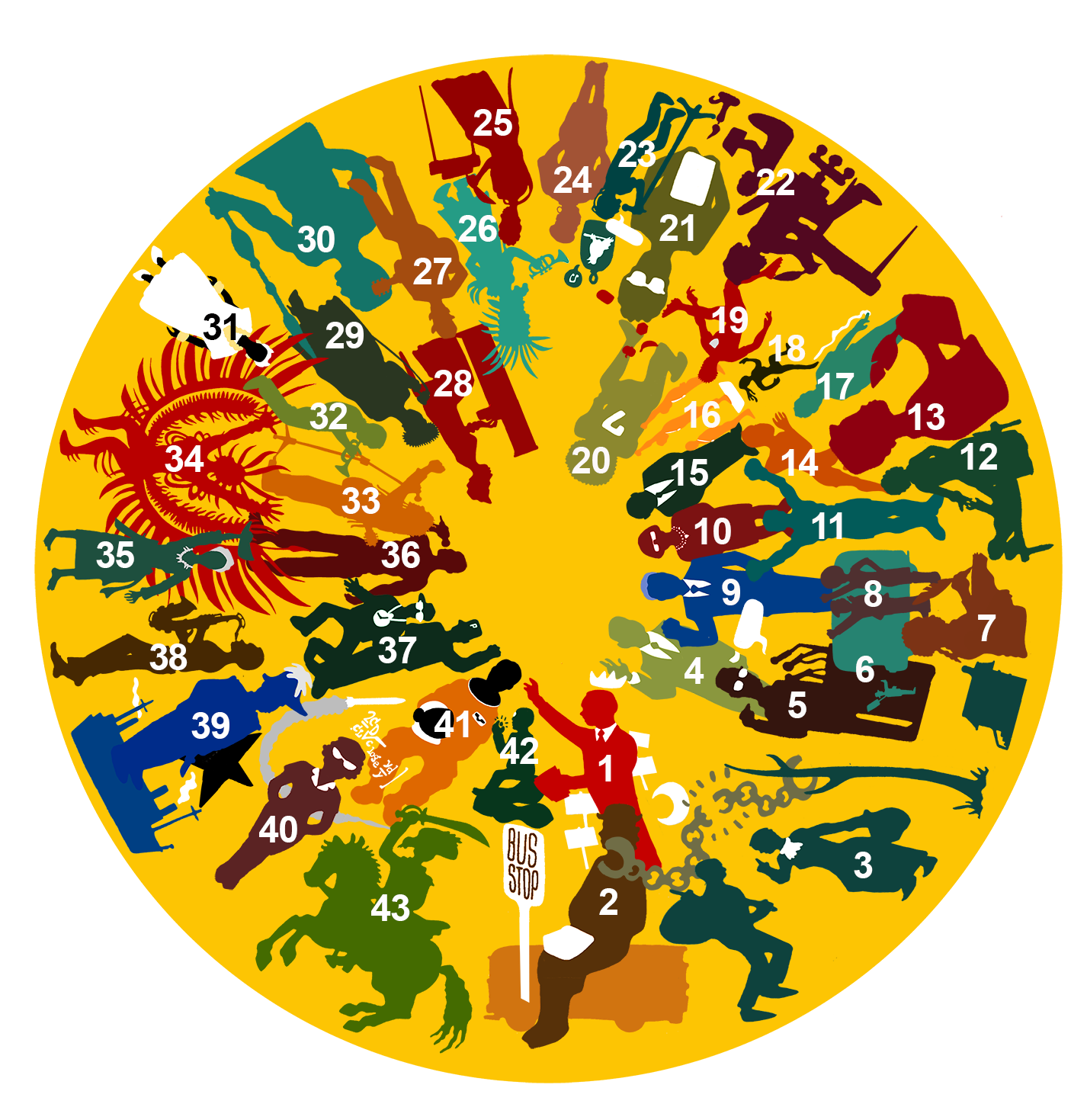
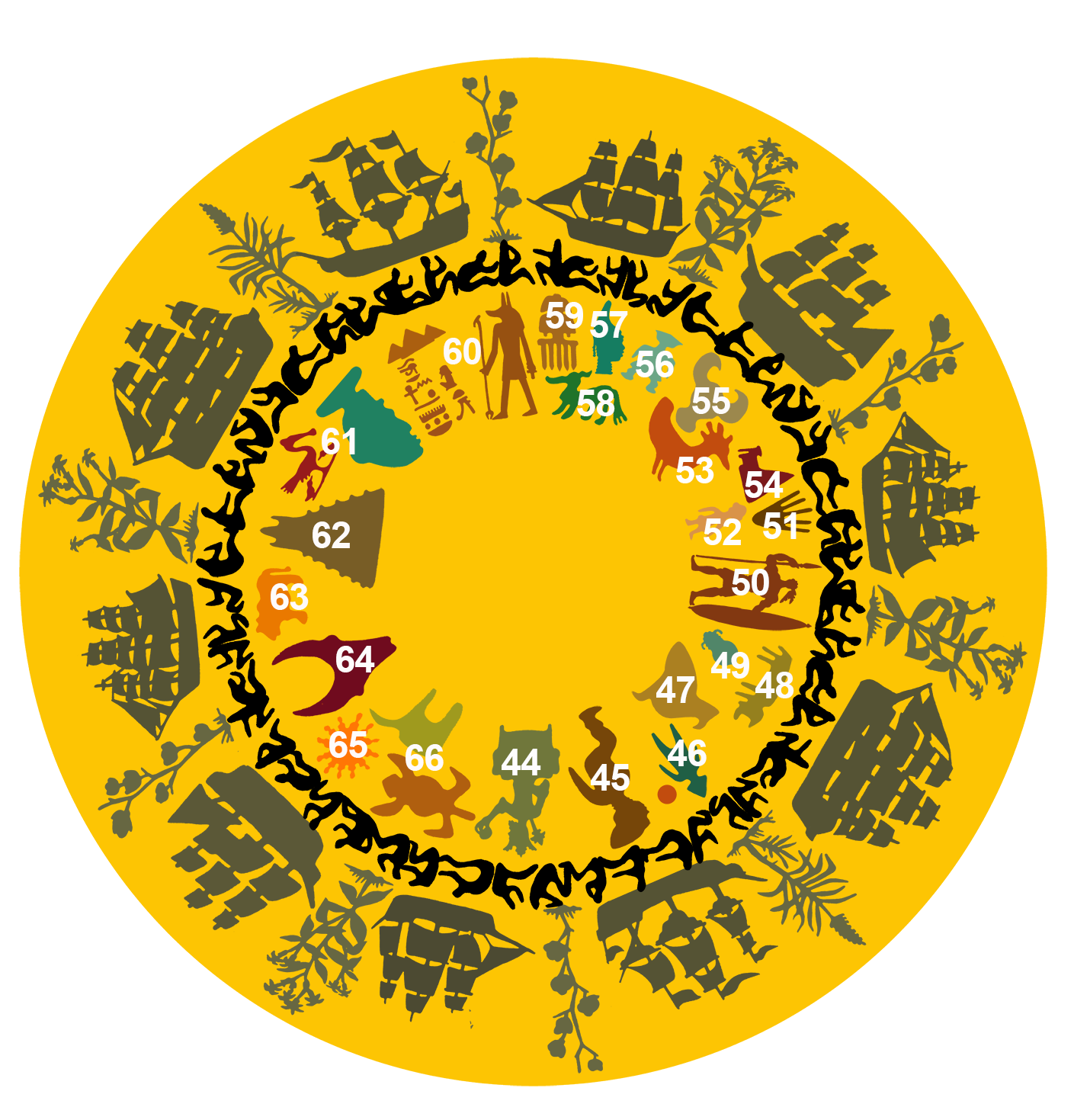
Maya Angelou’s poem – which this theme’s title paraphrases – tells of courage, hope and joy, despite the burden history puts upon the people of the African diaspora. I chose this theme, therefore, because it echoes a desire within my family to raise our children to honour and celebrate figures from a Black History which the Transatlantic Trade in Enslaved Africans is a part, but not the defining period, whilst never minimising its traumatic legacy.
It feels vital to ensure these atrocities alone do not define our children’s sense of their history, heritage and by extension, their identities; and that learning about the lives of the incredible people of African descent who overcame adversity and struggles to achieve amazing things is a powerful, joyful way to achieve this.
Whilst researching I have learnt so much about individuals seemingly hidden from ‘popular’ history – such as Nzinga Mbandi, queen of Ndongo and Matamba, or Brazilian quilombola leader Zumbi Dos Palmares – and people from the breadth of the African diaspora, who have a multitude of achievements across millennia around the globe.
My aim for my piece is to share a reimagined historical narrative in a public space that will be shared in a spirit of celebration; whilst simultaneously memorialising and paying homage to the enslaved African people who died as a consequence of the transatlantic trade – their names mostly forgotten – remembered here as a painful, haunting scar encircling the work.
Felix 'FLX' Braun is a contemporary fine artist and muralist, who lives and works in Bristol, UK. A veteran of the first wave of British graffiti and street art, he began painting walls in Bristol in 1984, aged 15, before going on to study for a degree in Visual Communication at the University of Central England at Birmingham, from which he graduated in 1993.
After studying for a Diploma in Youth Work at City of Bristol College in 2002, he combined his arts practice and youth work as a community arts facilitator, painting murals and delivering related youth arts projects, across Bristol and the UK, then subsequently as far afield as South East Asia and East Africa.
In 2012 he co-founded the community murals collective Paintsmiths of Bristol, whose large scale works celebrating the life of Nelson Mandela or parodying the ‘special relationship’ between Donald Trump and Boris Johnson, gained global media attention; whilst their murals in schools and community settings focused on celebrating those communities in everything from aerosol and masonry paint to retro reflective road marking materials.
These days his focus is on his personal studio practice and solo mural/public art projects.
Felix's design responds to the theme ‘Still We Rise’, which recognises and honours the enslaved and their descendants who resisted, who succeeded, and who broke new ground. We honour the well-known and celebrated, and shed light on untold legacies and events.
Guide to Historical Figures and Artefacts


Maya Angelou’s poem – which this theme’s title paraphrases – tells of courage, hope and joy, despite the burden history puts upon the people of the African diaspora. I chose this theme, therefore, because it echoes a desire within my family to raise our children to honour and celebrate figures from a Black History which the Transatlantic Trade in Enslaved Africans is a part, but not the defining period, whilst never minimising its traumatic legacy.
It feels vital to ensure these atrocities alone do not define our children’s sense of their history, heritage and by extension, their identities; and that learning about the lives of the incredible people of African descent who overcame adversity and struggles to achieve amazing things is a powerful, joyful way to achieve this.
Whilst researching I have learnt so much about individuals seemingly hidden from ‘popular’ history – such as Nzinga Mbandi, queen of Ndongo and Matamba, or Brazilian quilombola leader Zumbi Dos Palmares – and people from the breadth of the African diaspora, who have a multitude of achievements across millennia around the globe.
My aim for my piece is to share a reimagined historical narrative in a public space that will be shared in a spirit of celebration; whilst simultaneously memorialising and paying homage to the enslaved African people who died as a consequence of the transatlantic trade – their names mostly forgotten – remembered here as a painful, haunting scar encircling the work.
Felix 'FLX' Braun is a contemporary fine artist and muralist, who lives and works in Bristol, UK. A veteran of the first wave of British graffiti and street art, he began painting walls in Bristol in 1984, aged 15, before going on to study for a degree in Visual Communication at the University of Central England at Birmingham, from which he graduated in 1993.
After studying for a Diploma in Youth Work at City of Bristol College in 2002, he combined his arts practice and youth work as a community arts facilitator, painting murals and delivering related youth arts projects, across Bristol and the UK, then subsequently as far afield as South East Asia and East Africa.
In 2012 he co-founded the community murals collective Paintsmiths of Bristol, whose large scale works celebrating the life of Nelson Mandela or parodying the ‘special relationship’ between Donald Trump and Boris Johnson, gained global media attention; whilst their murals in schools and community settings focused on celebrating those communities in everything from aerosol and masonry paint to retro reflective road marking materials.
These days his focus is on his personal studio practice and solo mural/public art projects.


Bryony's design responds to the theme ‘Still We Rise’, which recognises and honours the enslaved and their descendants who resisted, who succeeded, and who broke new ground. We honour the well-known and celebrated, and shed light on untold legacies and events.
Tributaries Of Knowledge celebrates the legacy of Kenyan environmental activist Wangari Maathai and the seeds she planted during a remarkable lifetime.
Maathai was tenacious and a pioneer. She thought globally and acted locally, leading the fight against environmental degradation in Kenya with an activism that was intersectional; she understood environmental justice to be intrinsically tied to social justice, particularly women’s rights, many years before others in the environmental movement saw the connection. She also understood that sustainable development needed to embrace democracy, culture and religion if it were to be successfully embedded into the fabric of society.
In 1977, in response to rivers and streams drying up affecting food supplies in rural areas, she founded the grassroots organisation the Green Belt Movement, supporting women to work together to grow seedlings and plant trees to bind the soil, store rainwater, provide food and firewood. Today, the movement has planted some 51 million trees in Kenya. Wangari Maathai also worked tirelessly to demand greater democratic space and more accountability of the government in Kenya, which resulted in periods of imprisonment throughout her life. Still, she did not give up. She was tenacious.
In 2004, Wangari Maathai became the first African woman and environmentalist to win the Nobel Peace Prize.
I came across her work in 2011. Just days after I first landed in Africa for a placement at National Museums Kenya, news broke that Maathai had passed away. An incredible national and international outpouring of grief and remembrance followed for days, if not weeks. It was an intense and inspiring way to become acquainted with her work.
The experience sparked for me the question of how I could contribute to positive, constructive, and inclusive responses to the environmental crisis. Her story made me want to join the dots that those in power could not or would not acknowledge and to work interdisciplinarity to hold space for intersectional conversations about our relationship to nature within the public realm. She showed me that one’s efforts need not be so big that they are unimaginable. It can be a simple as planting a tree.
Tributaries of Knowledge references Wangari Maathai’s memoir, in which she recounts growing up near an old fig tree considered sacred by her community. As a child she found the tree and the spring that rose from its roots enchanting. As an adult she understood that her community’s reverence for the tree meant that it provided them with many levels of protection and sustenance.
In designing this globe, I wanted to depict Maathai’s description of her journey to founding the Green Belt Movement as being nourished and informed by many tributaries of knowledge, starting with that first fig tree. While painting, I reflected on how her legacy has shaped the environmental movement in Kenya and beyond, and what seeds she has planted that are only just germinating now, perhaps through unexpected encounters such as my own.
Bryony Benge-Abbott is a British Trinidadian artist working in painting, wild drawing walks, textiles, installation and street art. Combining visual arts with a 13 year background producing science and social history exhibitions, most recently establishing and leading the exhibitions programme at the UK’s largest lab, The Francis Crick Institute, Bryony works interdisciplinarily to shine a light on narratives about our relationship to the natural world that are under-told or overlooked. Much of her public art involves collaborating with scientists and the public to explore nature connectedness. In 2019 her commitment to public engagement through street art was acknowledged by the Mayor of London, who highlighted Bryony as a ‘hidden credit to the city’ as part of the International Women’s Day celebrations. In the studio, her artist research is interested in ways to transform the way in which we relate to nature, considering alternative perspectives and potential for change that lie in the entangled space where art, science and spirituality meet.
Bryony's design responds to the theme ‘Still We Rise’, which recognises and honours the enslaved and their descendants who resisted, who succeeded, and who broke new ground. We honour the well-known and celebrated, and shed light on untold legacies and events.
Tributaries Of Knowledge celebrates the legacy of Kenyan environmental activist Wangari Maathai and the seeds she planted during a remarkable lifetime.
Maathai was tenacious and a pioneer. She thought globally and acted locally, leading the fight against environmental degradation in Kenya with an activism that was intersectional; she understood environmental justice to be intrinsically tied to social justice, particularly women’s rights, many years before others in the environmental movement saw the connection. She also understood that sustainable development needed to embrace democracy, culture and religion if it were to be successfully embedded into the fabric of society.
In 1977, in response to rivers and streams drying up affecting food supplies in rural areas, she founded the grassroots organisation the Green Belt Movement, supporting women to work together to grow seedlings and plant trees to bind the soil, store rainwater, provide food and firewood. Today, the movement has planted some 51 million trees in Kenya. Wangari Maathai also worked tirelessly to demand greater democratic space and more accountability of the government in Kenya, which resulted in periods of imprisonment throughout her life. Still, she did not give up. She was tenacious.
In 2004, Wangari Maathai became the first African woman and environmentalist to win the Nobel Peace Prize.
I came across her work in 2011. Just days after I first landed in Africa for a placement at National Museums Kenya, news broke that Maathai had passed away. An incredible national and international outpouring of grief and remembrance followed for days, if not weeks. It was an intense and inspiring way to become acquainted with her work.
The experience sparked for me the question of how I could contribute to positive, constructive, and inclusive responses to the environmental crisis. Her story made me want to join the dots that those in power could not or would not acknowledge and to work interdisciplinarity to hold space for intersectional conversations about our relationship to nature within the public realm. She showed me that one’s efforts need not be so big that they are unimaginable. It can be a simple as planting a tree.
Tributaries of Knowledge references Wangari Maathai’s memoir, in which she recounts growing up near an old fig tree considered sacred by her community. As a child she found the tree and the spring that rose from its roots enchanting. As an adult she understood that her community’s reverence for the tree meant that it provided them with many levels of protection and sustenance.
In designing this globe, I wanted to depict Maathai’s description of her journey to founding the Green Belt Movement as being nourished and informed by many tributaries of knowledge, starting with that first fig tree. While painting, I reflected on how her legacy has shaped the environmental movement in Kenya and beyond, and what seeds she has planted that are only just germinating now, perhaps through unexpected encounters such as my own.
Bryony Benge-Abbott is a British Trinidadian artist working in painting, wild drawing walks, textiles, installation and street art. Combining visual arts with a 13 year background producing science and social history exhibitions, most recently establishing and leading the exhibitions programme at the UK’s largest lab, The Francis Crick Institute, Bryony works interdisciplinarily to shine a light on narratives about our relationship to the natural world that are under-told or overlooked. Much of her public art involves collaborating with scientists and the public to explore nature connectedness. In 2019 her commitment to public engagement through street art was acknowledged by the Mayor of London, who highlighted Bryony as a ‘hidden credit to the city’ as part of the International Women’s Day celebrations. In the studio, her artist research is interested in ways to transform the way in which we relate to nature, considering alternative perspectives and potential for change that lie in the entangled space where art, science and spirituality meet.


Pauline's design responds to the theme ‘Expanding Soul’, which celebrates the spirit and culture of the African diaspora that, even in the face of incredible suffering, has endured and found vibrant expression across the world in music, art, food and so much more.
For the theme Expanding Soul I thought about all the things that Africa has given the world; but there were so many elements it was impossible to include everything on one globe!
I decided to focus on music, the geometric patterns of African cloth that have influenced so much textile and fashion design, and the spiritual symbols of West Africa.
In recent years I have often produced site-specific installations in metal and mixed medium work for the public realm. As a multidisciplinary artist, I also work in a range of other mediums within my engaged practice, including textiles, photography, and video.
Regardless of the medium, my individual art practice is generally informed by the multiple layers of diverse cultures and heritage of the African diaspora.
As a visual artist and curator, Pauline Bailey has led numerous art projects centred around engagement, equality, and diversity working with a range of excluded and vulnerable groups to find creative expression, particularly to address issues around heritage, identity, sense of place, health and wellbeing.
She is one of the core members of the Black Arts Forum and Handsworth Creative based in Birmingham and also co-founder of the Daughters of Africa Foundation in the Gambia.
Pauline has curated and exhibited work nationally and internationally and is continuing to develop opportunities for emerging artists internationally alongside her individual visual arts practice. Pauline’s practice has always centred around identity and belonging, and she also has a strong interest in other themes such as ‘dereliction’, the natural environment, found/recycled materials and objects of the everyday.
Pauline’s individual art practice is generally informed by the multiple layers of diverse cultures and heritage of the African diaspora.
Pauline's design responds to the theme ‘Expanding Soul’, which celebrates the spirit and culture of the African diaspora that, even in the face of incredible suffering, has endured and found vibrant expression across the world in music, art, food and so much more.
For the theme Expanding Soul I thought about all the things that Africa has given the world; but there were so many elements it was impossible to include everything on one globe!
I decided to focus on music, the geometric patterns of African cloth that have influenced so much textile and fashion design, and the spiritual symbols of West Africa.
In recent years I have often produced site-specific installations in metal and mixed medium work for the public realm. As a multidisciplinary artist, I also work in a range of other mediums within my engaged practice, including textiles, photography, and video.
Regardless of the medium, my individual art practice is generally informed by the multiple layers of diverse cultures and heritage of the African diaspora.
As a visual artist and curator, Pauline Bailey has led numerous art projects centred around engagement, equality, and diversity working with a range of excluded and vulnerable groups to find creative expression, particularly to address issues around heritage, identity, sense of place, health and wellbeing.
She is one of the core members of the Black Arts Forum and Handsworth Creative based in Birmingham and also co-founder of the Daughters of Africa Foundation in the Gambia.
Pauline has curated and exhibited work nationally and internationally and is continuing to develop opportunities for emerging artists internationally alongside her individual visual arts practice. Pauline’s practice has always centred around identity and belonging, and she also has a strong interest in other themes such as ‘dereliction’, the natural environment, found/recycled materials and objects of the everyday.
Pauline’s individual art practice is generally informed by the multiple layers of diverse cultures and heritage of the African diaspora.


Kwaku's design responds to the theme ‘Still We Rise’, which recognises and honours the enslaved and their descendants who resisted, who succeeded, and who broke new ground. We honour the well-known and celebrated, and shed light on untold legacies and events.
This globe looks to recognise how even when faced with adversity, cooperation and sacrifice within the Black community has led to the conquering of obstacles and barriers throughout history. From our darkest times in slavery and colonialism, to problems faced today, people of African descent have somehow managed to thrive, excel and ascend into a reimagined future.
My design focuses on themes of sacrifice and cooperation to rise and excel through adversity. The kneeling figures holding up the path above represent those who have sacrificed so much to overcome obstacles in their journey; laying a firm foundation from which their descendants can build on and continue to climb higher.
Despite this narrative starting in darkness, the figures are adorned with golden halos to show that this is not the beginning of our story – in fact the destination at the top of the globe is one they have been to before. Whilst each step signifies a new generation, the figures are shown helping each other ascend from the darkness and towards a brighter future.
Kwaku Anokye is promising young artist from Ghana and Dominica. He was born in Hong Kong and has lived in Tokyo, London and Ghana. Working primarily with acrylic, spray and oil paint; Kwaku has also worked digitally and in fashion.
Despite his classical and figurative background in portraiture and live drawing; Kwaku’s work has become more abstract, drawing from his diverse upbringing to inform his artistic style. He combines elements of traditional African art and hip-hop culture to graffiti and Japanese Manga, using simplistic figures and bold colours to explore his past experiences.
Through his art, Kwaku strives to understand, and reconcile the different thoughts, episodes and emotions which continue to define him as a person and as an artist; creating complex, abstract compositions to highlight how perceived dichotomies within the human experience can work together in harmony.
This sentiment is best illustrated by the two Adinkra symbols which act as his signature, and appear on his globe: Nkonsonkonson (a chain link), a symbol representative of the strength which results from unity; and Ese ne tekrema, a proverb explaining that like teeth and tongue within the mouth, elements that coexist may have conflict, but must work together for the entity to thrive.
Kwaku's design responds to the theme ‘Still We Rise’, which recognises and honours the enslaved and their descendants who resisted, who succeeded, and who broke new ground. We honour the well-known and celebrated, and shed light on untold legacies and events.
This globe looks to recognise how even when faced with adversity, cooperation and sacrifice within the Black community has led to the conquering of obstacles and barriers throughout history. From our darkest times in slavery and colonialism, to problems faced today, people of African descent have somehow managed to thrive, excel and ascend into a reimagined future.
My design focuses on themes of sacrifice and cooperation to rise and excel through adversity. The kneeling figures holding up the path above represent those who have sacrificed so much to overcome obstacles in their journey; laying a firm foundation from which their descendants can build on and continue to climb higher.
Despite this narrative starting in darkness, the figures are adorned with golden halos to show that this is not the beginning of our story – in fact the destination at the top of the globe is one they have been to before. Whilst each step signifies a new generation, the figures are shown helping each other ascend from the darkness and towards a brighter future.
Kwaku Anokye is promising young artist from Ghana and Dominica. He was born in Hong Kong and has lived in Tokyo, London and Ghana. Working primarily with acrylic, spray and oil paint; Kwaku has also worked digitally and in fashion.
Despite his classical and figurative background in portraiture and live drawing; Kwaku’s work has become more abstract, drawing from his diverse upbringing to inform his artistic style. He combines elements of traditional African art and hip-hop culture to graffiti and Japanese Manga, using simplistic figures and bold colours to explore his past experiences.
Through his art, Kwaku strives to understand, and reconcile the different thoughts, episodes and emotions which continue to define him as a person and as an artist; creating complex, abstract compositions to highlight how perceived dichotomies within the human experience can work together in harmony.
This sentiment is best illustrated by the two Adinkra symbols which act as his signature, and appear on his globe: Nkonsonkonson (a chain link), a symbol representative of the strength which results from unity; and Ese ne tekrema, a proverb explaining that like teeth and tongue within the mouth, elements that coexist may have conflict, but must work together for the entity to thrive.


| St Peter's Square, LE1 4AN |
Hannaa's design responds to the theme ‘Still We Rise’, which recognises and honours the enslaved and their descendants who resisted, who succeeded, and who broke new ground. We honour the well-known and celebrated, and shed light on untold legacies and events.
Our globe takes the power, resistance and beauty of Black people and celebrates them in a unified design. Painted onto a black background, the 54 national flowers of each African country are positioned across the equator of the globe, alongside a green, chain-inspired, vine motif. This design symbolises the ecosystem of the Black community and the important role that each member plays.
It celebrates the joy and flourishing of Black people – not just their survival. Through natural imagery, the resistance and resilience of the Black community is centred. The green, chain-inspired, vine motif is a representation of the legacy of generations before, commemorating the power of Black ancestors and celebrating their determination and persistence. It represents the continuation of progress, with green linking to nature’s strength, power and reclamation.
These inspired patterns also nod to what enslaved Africans broke away from in the fight for their freedom. Flowers have been placed around the equator of the globe, to mirror the linking of arms in protest, symbolising the unity and strength in the communal power of Black people and their allies. It highlights the contribution of Black people to society across the world and commemorates the African diaspora.
For countries where there are duplicated flowers or non-declared national flowers, a bud is used to recognise the continued work that needs to be done to combat racism, as well as marking the growth and progress that we have already seen as a society and the potential yet to come. The design of this globe has been co-created with young people from the East Midlands.
Hannaa Hamdache is an artist and curator of mixed English and Algerian heritage. Based in Nottingham, UK, she holds a BA (Hons) in Fine Art and Art History from Kingston University London and an MLitt in Curatorial Practice (Contemporary Art) from the Glasgow School of Art. She works to make the arts open for all through the use of humour and education. Her practice explores the idea of play: playing with context, the exhibition and the everyday.
Hannaa's design responds to the theme ‘Still We Rise’, which recognises and honours the enslaved and their descendants who resisted, who succeeded, and who broke new ground. We honour the well-known and celebrated, and shed light on untold legacies and events.
Our globe takes the power, resistance and beauty of Black people and celebrates them in a unified design. Painted onto a black background, the 54 national flowers of each African country are positioned across the equator of the globe, alongside a green, chain-inspired, vine motif. This design symbolises the ecosystem of the Black community and the important role that each member plays.
It celebrates the joy and flourishing of Black people – not just their survival. Through natural imagery, the resistance and resilience of the Black community is centred. The green, chain-inspired, vine motif is a representation of the legacy of generations before, commemorating the power of Black ancestors and celebrating their determination and persistence. It represents the continuation of progress, with green linking to nature’s strength, power and reclamation.
These inspired patterns also nod to what enslaved Africans broke away from in the fight for their freedom. Flowers have been placed around the equator of the globe, to mirror the linking of arms in protest, symbolising the unity and strength in the communal power of Black people and their allies. It highlights the contribution of Black people to society across the world and commemorates the African diaspora.
For countries where there are duplicated flowers or non-declared national flowers, a bud is used to recognise the continued work that needs to be done to combat racism, as well as marking the growth and progress that we have already seen as a society and the potential yet to come. The design of this globe has been co-created with young people from the East Midlands.
Hannaa Hamdache is an artist and curator of mixed English and Algerian heritage. Based in Nottingham, UK, she holds a BA (Hons) in Fine Art and Art History from Kingston University London and an MLitt in Curatorial Practice (Contemporary Art) from the Glasgow School of Art. She works to make the arts open for all through the use of humour and education. Her practice explores the idea of play: playing with context, the exhibition and the everyday.


| Town Hall Square, Every St, LE1 6AG |
Jarvis' design responds to the theme ‘Reimagine the Future’, which gives us free rein to imagine the society we can create when we have a full understanding of our shared history; the place the UK can hold in the world when it acknowledges its past; and who we can be as people and a country when we give full dignity to all.
After exploring the theme to which I am responding, Reimagine The Future, several keywords and phrases presented themselves to me; from roots to fruit; vitality; courage; fluidity; unwavering; and the divine feminine.
All of which I felt are emblematic of the transmutation of the pain, suffering, and darkness our ancestors endured, into a source of tremendous power and light.
What I wanted to offer in relation to these is an energetic response where the green whimsical and fluid lines blend into light, warm and sparkling yellow areas that in parts surround semi-abstract flowers. The fluid and soft lines could be interpreted as a celebration of the unwavering nature of the human spirit to continuously rise above adversity and adapt – like water – endlessly curving around seemingly immovable rocks in a river. The abstract flowers – bright and pink – could be seen as symbolic of the divine feminine and creative processes of renewal, the beginning of a new legacy.
The main colours – pink, yellow, and blue-green – have been inspired, but slightly adapted, by the colours of the Cameroonian flag, which forms part of my own mixed heritage.
What I hope that my globe will offer people, is an opportunity for all of us to meditate and contemplate upon the things about our humanity that historically and cross-culturally unite us all as opposed to what divides us. ‘God has written evil into the storyline of life, but it generally takes a positive trajectory, so that what you end up with is not a tragedy but a tale of hope and inspiration.’ – Jesse Coueavhoven. Still, we rise.
Born in Croydon, England in 1992, Brookfield grew up in Derby and studied Fine art in Leicester, where he attended De Montfort University. He’s won the peoples choice award as part of the Robert Walters UK New Artist of the year award 2021 and he has had his work featured on Creativeboom and Juxtapoz. Brookfield is currently pursuing a life of art-making in Leicester, England.
Jarvis' design responds to the theme ‘Reimagine the Future’, which gives us free rein to imagine the society we can create when we have a full understanding of our shared history; the place the UK can hold in the world when it acknowledges its past; and who we can be as people and a country when we give full dignity to all.
After exploring the theme to which I am responding, Reimagine The Future, several keywords and phrases presented themselves to me; from roots to fruit; vitality; courage; fluidity; unwavering; and the divine feminine.
All of which I felt are emblematic of the transmutation of the pain, suffering, and darkness our ancestors endured, into a source of tremendous power and light.
What I wanted to offer in relation to these is an energetic response where the green whimsical and fluid lines blend into light, warm and sparkling yellow areas that in parts surround semi-abstract flowers. The fluid and soft lines could be interpreted as a celebration of the unwavering nature of the human spirit to continuously rise above adversity and adapt – like water – endlessly curving around seemingly immovable rocks in a river. The abstract flowers – bright and pink – could be seen as symbolic of the divine feminine and creative processes of renewal, the beginning of a new legacy.
The main colours – pink, yellow, and blue-green – have been inspired, but slightly adapted, by the colours of the Cameroonian flag, which forms part of my own mixed heritage.
What I hope that my globe will offer people, is an opportunity for all of us to meditate and contemplate upon the things about our humanity that historically and cross-culturally unite us all as opposed to what divides us. ‘God has written evil into the storyline of life, but it generally takes a positive trajectory, so that what you end up with is not a tragedy but a tale of hope and inspiration.’ – Jesse Coueavhoven. Still, we rise.
Born in Croydon, England in 1992, Brookfield grew up in Derby and studied Fine art in Leicester, where he attended De Montfort University. He’s won the peoples choice award as part of the Robert Walters UK New Artist of the year award 2021 and he has had his work featured on Creativeboom and Juxtapoz. Brookfield is currently pursuing a life of art-making in Leicester, England.

Login or Register to track the Globes you visit for chance to win a FREE copy of The World Reimagined book!
Find Out More


Artist Globe |
Learning Globe |
Points of Interest |